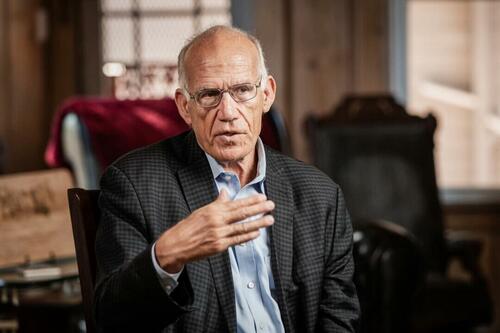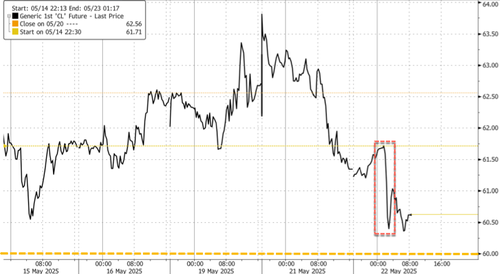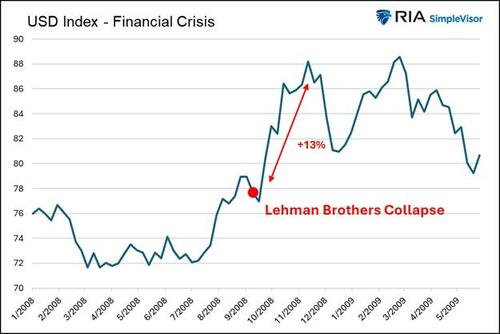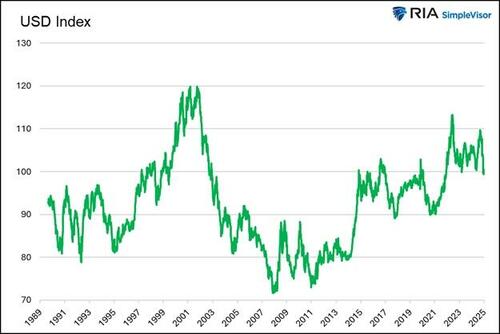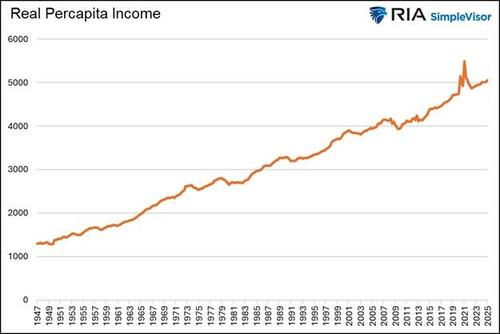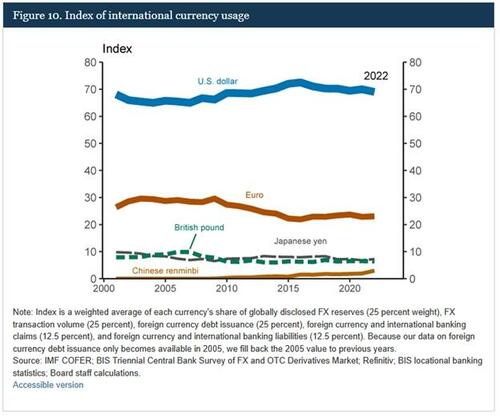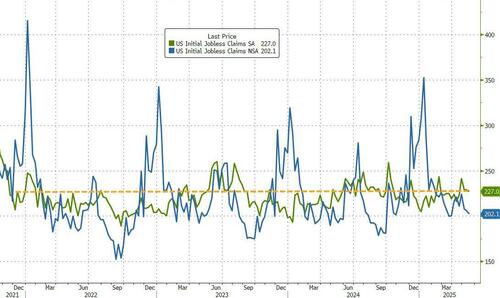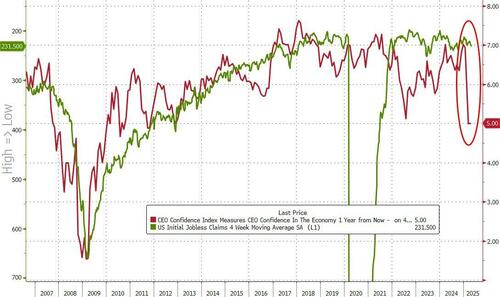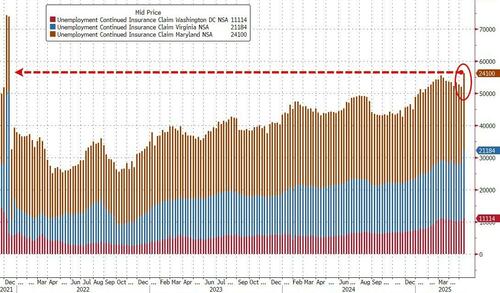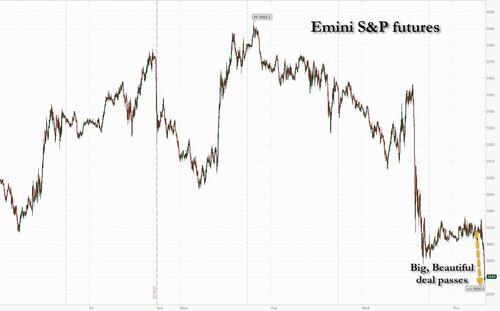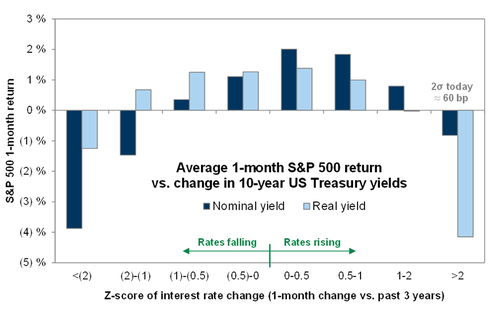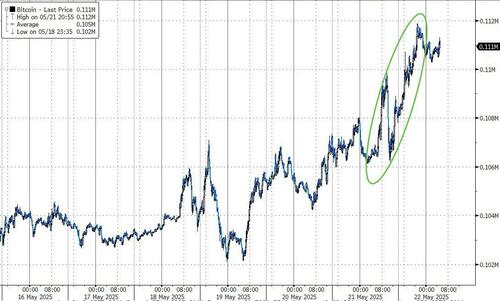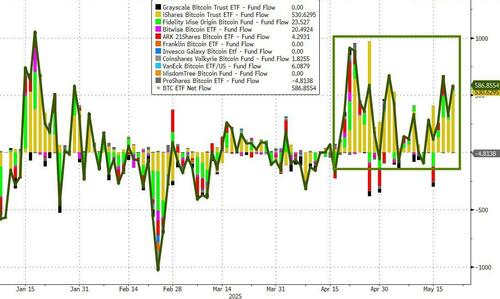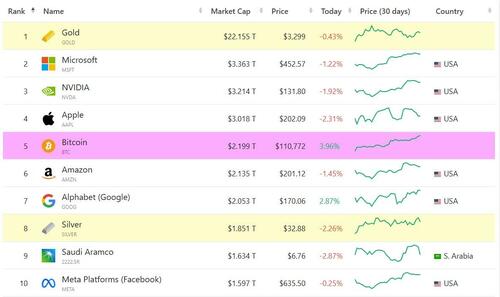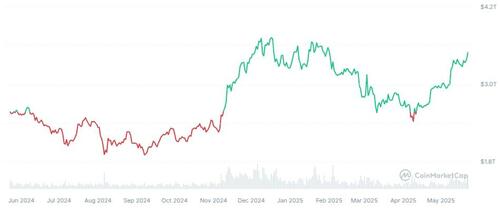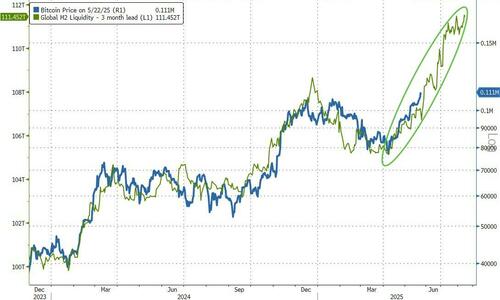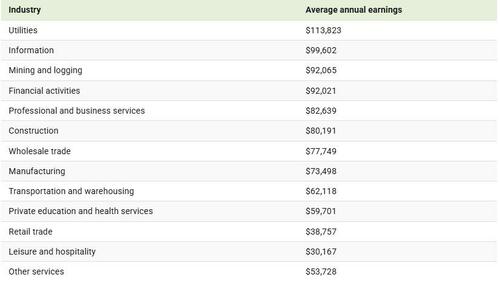In proclaiming the faith and in administering the sacraments every priest speaks on behalf of Jesus Christ, for Jesus Christ.
Distinction Matter - Subscribed Feeds
-
Site: Mises InstitutePresident Trump has made a lot of noise in the business community in the first few months of his administration. Unfortunately, his actions and rhetoric have created a lot of uncertainty in the economy, threatening capital development.
-
Site: Henrymakow.com
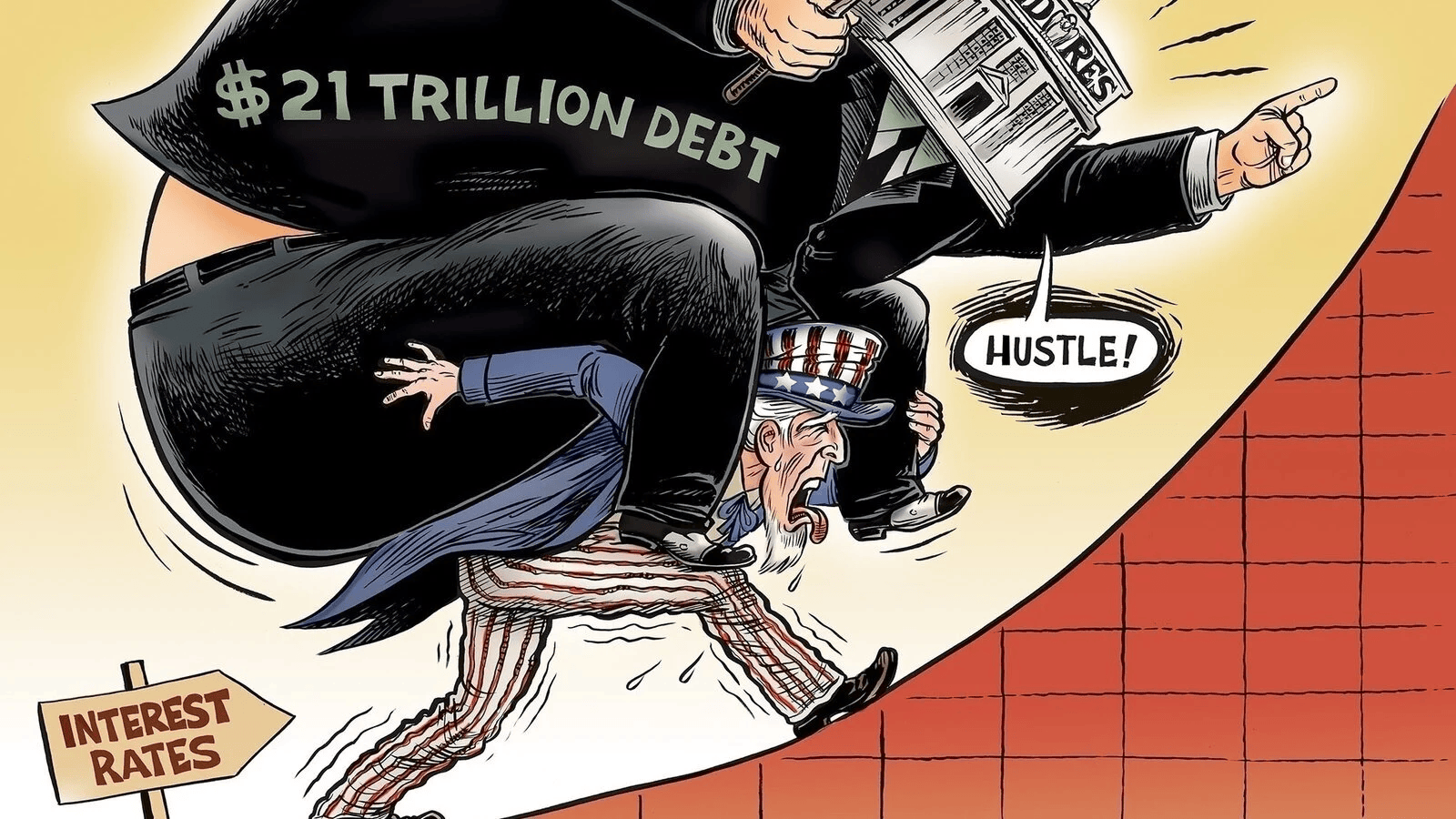 (The debt is now $37 Trillion and counting)Peace talks are stalled in Ukraine and the ME.The world is refusing to finance the burgeoning US DEBT.In spite of this, Trump is planning tax cuts for the rich and a $150 billion "Golden Dome" defence shield."After an all night vote, the US narrowly passed the budget bill in the House that would increase federal deficits by $4 trillion, according to the Congressional Budget Office. This is largely through tax cuts. To offset the lower revenue from taxes, the budget cuts spending by $1 trillion on the back of reduced eligibility for Medicaid and food stamps. Plainly, it's a budget that benefits the highest income earners while limiting resources for the lowest income earners." - Amber KanwarThomas Stone--Federal Reserve is intentionally blowing it up"Yes, the only conclusion I can make is that the Federal Reserve is effectively restricting credit at the worst time on purpose to blow it all up. Let me explain."QE turned the Federal government into a crack addict. Believe me on this one, the Federal Reserve is not being stupid. It is carrying out its instructions to blow it all up.The Fed is absolutely laying it all waste by leaving interest rates persistently elevated above official rates of inflation while they continue to roll off existing Treasury inventory from its balance sheet. The rest of the world cannot replace the Fed's former Treasury demand. If it could, long-term bond yields wouldn't be continuing to creep higher.How stupid can the Fed be? In another couple years, the Federal government interest expenses will hit $1.5 trillion annually."-Trump's Bill Cuts Medicare, Gives to Pentagon. Rep. Massie Says Bill Adds $20 TRILLION to the DebtMeanwhile, zero cuts were made to the Pentagon, instead, about $10 billion was funnelled into it.About 80 million Americans get Medicare and 70 million get Medicaid. Analysis from the congressional budget office shows that 7.6 million people would lose their Medicaid coverage if the current House proposal becomes law. 63% of nursing home care is funded by Medicaid. The bill would also cut 3 million people from the SNAP food stamps program. The Joint Committee on Taxation (JCT) estimated that the bill as written would increase deficits by $3.8 trillion through to 2034.--
(The debt is now $37 Trillion and counting)Peace talks are stalled in Ukraine and the ME.The world is refusing to finance the burgeoning US DEBT.In spite of this, Trump is planning tax cuts for the rich and a $150 billion "Golden Dome" defence shield."After an all night vote, the US narrowly passed the budget bill in the House that would increase federal deficits by $4 trillion, according to the Congressional Budget Office. This is largely through tax cuts. To offset the lower revenue from taxes, the budget cuts spending by $1 trillion on the back of reduced eligibility for Medicaid and food stamps. Plainly, it's a budget that benefits the highest income earners while limiting resources for the lowest income earners." - Amber KanwarThomas Stone--Federal Reserve is intentionally blowing it up"Yes, the only conclusion I can make is that the Federal Reserve is effectively restricting credit at the worst time on purpose to blow it all up. Let me explain."QE turned the Federal government into a crack addict. Believe me on this one, the Federal Reserve is not being stupid. It is carrying out its instructions to blow it all up.The Fed is absolutely laying it all waste by leaving interest rates persistently elevated above official rates of inflation while they continue to roll off existing Treasury inventory from its balance sheet. The rest of the world cannot replace the Fed's former Treasury demand. If it could, long-term bond yields wouldn't be continuing to creep higher.How stupid can the Fed be? In another couple years, the Federal government interest expenses will hit $1.5 trillion annually."-Trump's Bill Cuts Medicare, Gives to Pentagon. Rep. Massie Says Bill Adds $20 TRILLION to the DebtMeanwhile, zero cuts were made to the Pentagon, instead, about $10 billion was funnelled into it.About 80 million Americans get Medicare and 70 million get Medicaid. Analysis from the congressional budget office shows that 7.6 million people would lose their Medicaid coverage if the current House proposal becomes law. 63% of nursing home care is funded by Medicaid. The bill would also cut 3 million people from the SNAP food stamps program. The Joint Committee on Taxation (JCT) estimated that the bill as written would increase deficits by $3.8 trillion through to 2034.-- (Left, Bill Gates demonstrates Masonic handshake with Tedros)Members of the World Health Organisation ("WHO") adopted a global pandemic accord on Tuesday, 20 May 2025; 124 countries voted in favour, no countries voted against, while 11 countries abstained and 46 countries were not present. The total votes cast don't add up, but those are the numbers WHO has declared.For the countries that abstained - of which, shamefully, the UK was not one - their concerns included loss of national sovereignty, lack of legal clarity and the risk of unelected institutions imposing policy.-Iran warns of 'devastating and decisive response' if Israel attacks-Pam Blondi- Jilted - Leftists do a good job of demystifying Pam Bondi--KEENEY: Canada's universities, islands of oppression in a sea of freedom'The treason of the tenured... what Saint Mary's University reveals about the ideological capture of Canada's universities.'The modern university, once a sanctuary for critical inquiry and truth seeking, has become a laboratory for fashionable ideologies. Mark Mercer, a professor of philosophy at Saint Mary's University in Halifax and a longtime defender of academic freedom, has provided us with a disturbing case study that reveals the depth of this transformation.-
(Left, Bill Gates demonstrates Masonic handshake with Tedros)Members of the World Health Organisation ("WHO") adopted a global pandemic accord on Tuesday, 20 May 2025; 124 countries voted in favour, no countries voted against, while 11 countries abstained and 46 countries were not present. The total votes cast don't add up, but those are the numbers WHO has declared.For the countries that abstained - of which, shamefully, the UK was not one - their concerns included loss of national sovereignty, lack of legal clarity and the risk of unelected institutions imposing policy.-Iran warns of 'devastating and decisive response' if Israel attacks-Pam Blondi- Jilted - Leftists do a good job of demystifying Pam Bondi--KEENEY: Canada's universities, islands of oppression in a sea of freedom'The treason of the tenured... what Saint Mary's University reveals about the ideological capture of Canada's universities.'The modern university, once a sanctuary for critical inquiry and truth seeking, has become a laboratory for fashionable ideologies. Mark Mercer, a professor of philosophy at Saint Mary's University in Halifax and a longtime defender of academic freedom, has provided us with a disturbing case study that reveals the depth of this transformation.- Hamdy Mig--"Thanks to your donations, I bought a new tent, rented a small plot of land and put it inside, thank you"This is the last batch of flour, and the last bread left. A sack of wheat costs $600 here. No one can afford it, and we're at great risk of starvation. The financial situation is very difficult. Please help me buy a sack of wheat before it runs out in the city, and before we're hit by another great famine."-Israeli Strikes on Gaza Kill 82 as Aid Still Hasn't Reached PalestiniansThe UN says the small amount of aid that entered Gaza has been loaded onto UN trucks, but still hasn't been distributed due to unsafe conditionsKash Patel & Dan Bongino Repeat Epstein Suicide LIE! - YouTube. The Jimmy Dore Show.These two clowns have always been strong supporters of Israhell, so what did the MAGA cult members expect?!Virginia Governor Signs Executive Order for Safe Classrooms and Combatting Antisemitism in Higher Education - Israel365 News-Bribery Charges Sink Retired Admiral In Navy Ethics Scandalhttps://www.zerohedge.com/political/retired-admiral-convicted-navy-bribery-case-marking-historic-fall-top-military-officialBurke, 63, of Coconut Creek, Fla., was found guilty by a Washington jury after a five-day trial and three days of deliberation. Prosecutors said he steered a Navy training contract in 2021 to a New York-based company, Next Jump, in exchange for a $500,000-per-year job he was to begin after his retirement in 2022.--
Hamdy Mig--"Thanks to your donations, I bought a new tent, rented a small plot of land and put it inside, thank you"This is the last batch of flour, and the last bread left. A sack of wheat costs $600 here. No one can afford it, and we're at great risk of starvation. The financial situation is very difficult. Please help me buy a sack of wheat before it runs out in the city, and before we're hit by another great famine."-Israeli Strikes on Gaza Kill 82 as Aid Still Hasn't Reached PalestiniansThe UN says the small amount of aid that entered Gaza has been loaded onto UN trucks, but still hasn't been distributed due to unsafe conditionsKash Patel & Dan Bongino Repeat Epstein Suicide LIE! - YouTube. The Jimmy Dore Show.These two clowns have always been strong supporters of Israhell, so what did the MAGA cult members expect?!Virginia Governor Signs Executive Order for Safe Classrooms and Combatting Antisemitism in Higher Education - Israel365 News-Bribery Charges Sink Retired Admiral In Navy Ethics Scandalhttps://www.zerohedge.com/political/retired-admiral-convicted-navy-bribery-case-marking-historic-fall-top-military-officialBurke, 63, of Coconut Creek, Fla., was found guilty by a Washington jury after a five-day trial and three days of deliberation. Prosecutors said he steered a Navy training contract in 2021 to a New York-based company, Next Jump, in exchange for a $500,000-per-year job he was to begin after his retirement in 2022.-- Seminole Indians are claiming Mar a Lago and moving Trump and his family to Libya.ARCHBISHOP VIGANO IS SKEPTICAL OF THE CONCLAVE BECAUSE FRANCIS "CREATED" NEARLY 80 PERCENT OF THE CARDINALS WHO ELECTED LEO XIV:Vigano stated: "The death of Bergoglio crystallizes, so to speak, a situation of widespread illegitimacy. Of the 136 Cardinal electors, 108 were 'created' by him; which means that whatever Pope is elected in the upcoming Conclave - even if he were a new Saint Pius X - his authority will be compromised by having been elected by false cardinals, created by a false Pope. For this reason, some time ago, I asked my Brothers in the Episcopate to clarify these aspects before they proceed with the election of a new Pope".-Carney 'devastated and appalled' by killing of 2 Israeli embassy staff in Washington-RFK JR CALS OUT THE UN'S WORST HELL ORGANIZATION (WHO):On 20 May 2025, RFK Jr told the truth about the UN's Worst Hell Organization (WHO):Now we only need ZioFascist Donald Trump to apologize for the COVID-PHARMA GENOCIDE.-
Seminole Indians are claiming Mar a Lago and moving Trump and his family to Libya.ARCHBISHOP VIGANO IS SKEPTICAL OF THE CONCLAVE BECAUSE FRANCIS "CREATED" NEARLY 80 PERCENT OF THE CARDINALS WHO ELECTED LEO XIV:Vigano stated: "The death of Bergoglio crystallizes, so to speak, a situation of widespread illegitimacy. Of the 136 Cardinal electors, 108 were 'created' by him; which means that whatever Pope is elected in the upcoming Conclave - even if he were a new Saint Pius X - his authority will be compromised by having been elected by false cardinals, created by a false Pope. For this reason, some time ago, I asked my Brothers in the Episcopate to clarify these aspects before they proceed with the election of a new Pope".-Carney 'devastated and appalled' by killing of 2 Israeli embassy staff in Washington-RFK JR CALS OUT THE UN'S WORST HELL ORGANIZATION (WHO):On 20 May 2025, RFK Jr told the truth about the UN's Worst Hell Organization (WHO):Now we only need ZioFascist Donald Trump to apologize for the COVID-PHARMA GENOCIDE.- Bumblehive: The entrance to the NSA's Utah Data Center administration building. The purpose of the data center is to track "all forms of communication, including the complete contents of private emails, cell phone calls, and internet searches, as well as all types of personal data trails -- parking receipts, travel itineraries, bookstore purchases, and other digital 'pocket litter.'"Understanding and Countering Sentient World Simulation
Bumblehive: The entrance to the NSA's Utah Data Center administration building. The purpose of the data center is to track "all forms of communication, including the complete contents of private emails, cell phone calls, and internet searches, as well as all types of personal data trails -- parking receipts, travel itineraries, bookstore purchases, and other digital 'pocket litter.'"Understanding and Countering Sentient World Simulation -
Site: Zero HedgeSupreme Court Deadlocks, Leaves In Place Block On Nation's First Religious Charter SchoolTyler Durden Thu, 05/22/2025 - 12:20
Authored by Matthew Vadum via The Epoch Times (emphasis ours),
The U.S. Supreme Court on May 22 voted 4–4 to reject authorization for the nation’s first publicly funded religious charter school.
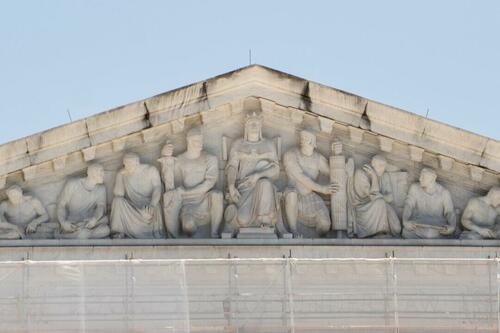 The U.S. Supreme Court in Washington on May 19, 2025. Madalina Vasiliu/The Epoch Times
The U.S. Supreme Court in Washington on May 19, 2025. Madalina Vasiliu/The Epoch Times
Justice Amy Coney Barrett recused herself and did not participate in the case known as Oklahoma Statewide Charter School Board v. Drummond. The respondent is Gentner Drummond, Oklahoma’s attorney general.
The Supreme Court’s unsigned opinion consists of one sentence: “The judgment is affirmed by an equally divided Court.” No reasons for the ruling were provided.
As the vote resulted in a tie, under court rules, the lower court ruling being appealed is affirmed.
On June 25, 2024, the Oklahoma Supreme Court ruled against the school, ordering the school board to cancel the contract and finding that the school was a governmental entity.
The court determined that, since the school was deemed a state actor, denying it charter status did not violate the free exercise clause.
The state court also found that the school’s contract with the school board violated the Oklahoma Constitution’s prohibition against “using public money for the benefit or support of any religious institution.”
This is a developing story and will be updated.
-
Site: Mises Institute30-year Treasury yield spikes to 5.09%, 10-year yield hits 4.61%. 10-yr yield is back at 2005 levels.
-
Site: Zero HedgeEco-Fascism - 2026 Ballot Measure Seeks "End Of Farming" In ColoradoTyler Durden Thu, 05/22/2025 - 11:55
The Trump administration, focused on delivering economic growth and food production in the U.S., is attracting the opposition of zealots and degrowth monied interests alike.
To wit; two radically authoritarian ballot measures - which have the support of initiatives and frameworks of International Governmental Organizations (IGOs) - ask Colorado and Oregon voters to give up the family dog and hand over their private property rights in what some have called "the end of farming and ranching" in the Mile High state.
Democrats in Colorado are preparing to permanently end farming in the state
— Wall Street Apes (@WallStreetApes) May 13, 2025
“This would be the end of farming and ranching and private (farm) land ownership in Colorado”
“There's something happening in Colorado which is not so good. The corridor of people that don't understand… pic.twitter.com/EDWu2KJNd8The first measure, Colorado ballot initiative 2025-2026#82, reads like a dictator's manifesto - and is essentially a carbon copy of the CCP-backed Convention on Biological Diversity's wildlands project.
The eight-page "Colorado Wildlife and Biodiversity Protection Act" seeks to create the Wildlife and Ecosystem Conservation Commission (WECC).
Astonishingly, the WECC would consist of nine appointed members, with the petition strictly stipulating that no member can have any financial ties to agriculture, energy, or development. The petition then goes on to (laughably) assert that these supposed "elite" members - without "financial ties" - will be appointed by universities, environmental groups, and policy institutes. Naturally, this commission will have total control over agriculture, energy, and all future development in Colorado.
Deal with the Devil
But, have no fear landowners, the petition miraculously provides 25-50% tax abatement for those willing to hand over 49-100% of their private lands as designated wildlands…in perpetuity.
Given the sheer naivete, and the multitudes of legal errors made by petitioners Jessica Presso and Cameron Porter, most would rightly assume the petition would be dead on arrival. Not so fast.
Within days, the Colorado Legislative Council Staff and Office of Legislative Legal Services sent Presso and Porter a nineteen-page how-to guide, effectively giving free legal advice by outlining the requirements for a final draft.
Similar to court filings, when initiated petitions fail to meet filing requirements for single subjects, or properly address statutory amendments, they're simply refused by the Secretary of State - placing the onus upon the petitioner(s) to seek legal advice. However, this departure from the norm now appears to be part of a growing trend in radical leftist states.
Oregon
Leading up to the 2022 election in Oregon, a similarly wonky Initiative Petition 13 was introduced to make raising, riding, eating or owning domestic livestock illegal. Similarly, the state donated resources to the petitioners by sending back a lengthy how-to guide.
After significant tweaks, that Initiative Petition is back as IP28 and greenlit for signature collection ahead of the 2026 election. In addition to making it illegal to own companion animals such as dogs or cats, the IP would make it illegal to render animals for meat in the State of Oregon.
While some might be quick to dismiss the actions of a few, seemingly lone environmental zealots, others cite bigger-picture concerns for connections to IGOs and dark money influence.
Last month, when the Trump administration delivered a long-awaited reform to the Endangered Species Act, monied interests immediately lashed out with threats.
"Trump is trying to drive a knife through the heart of the Endangered Species Act. This will absolutely upend how we've been protecting endangered species for the last 40-plus years," said Noah Greenwald of the Center for Biological Diversity, which makes its money by suing states and the federal government.
"The Center for Biological Diversity will no doubt join other groups in challenging the rule change in federal court," Greenwald added.
Yet by narrowly redefining "harm" as an illegal taking—such as removing or poaching—the Trump administration is attempting to rectify decades of federal overreach that have resulted in the loss of grazing rights on privately owned lands and the lowest cattle volumes in 70 years.
While America's farmers and ranchers are no strangers to authoritarian land grabs, many are now urging voters to take these state-level initiatives seriously as they're not only aligned with the degrowth agendas of foreign-backed IGOs but would also supplant private property rights with eco-fascism.
* * *
Save small ranchers, control your own food supply, and eat clean.
-
Site: Zero HedgeTrump Navigating Base's Opposition To Interventionism With Iran Talks: Victor Davis HansonTyler Durden Thu, 05/22/2025 - 11:30
Authored by Ryan Morgan and Jan Jekielek via The Epoch Times,
As President Donald Trump continues negotiations to limit Iran’s nuclear aspirations, historian and Hoover Institution senior fellow Victor Davis Hanson believes the president is preparing his non-interventionist supporters for the possibility of a more forceful confrontation in the Middle East.
On the 2024 campaign trail, Trump frequently touted his record of avoiding new wars during his first term and emphasized his plans to quickly resolve ongoing conflicts, like the one in Ukraine. At the same time, Trump has described his foreign policy approach as one of “peace through strength,” and he has been willing to threaten military action to press his agenda.
In March, as the U.S. president began his push for a new deal restricting Iran’s nuclear program, he warned, “If they don’t make a deal, there will be bombing.”
In a recent interview with Jan Jekielek, host of EpochTV’s “American Thought Leaders,” Hanson described Trump as having to thread the needle with how he handles his next steps with Iran.
“The MAGA covenant he ran on said no optional Middle East wars, no foreign entanglements, and it’s always better to jawbone than to go to war,” he said.
While the Trump administration has joined successive rounds of indirect talks with Iranian representatives, Hanson assessed that Israeli leaders feel the current moment is a good window of opportunity to strike Iran.
Even if the negotiations don’t result in a deal, Hanson said Trump could use the opportunity to acclimate his base to the Israeli point of view.
“He’s saying to Israel, ‘Let’s just get six or seven months of negotiation ... We‘ll negotiate to the point where they have to shut up or put up. And if you’re right ... then we have a case to be made to our MAGA base.’”
Syria
Hanson assessed Bashar al-Assad’s fall from power in Syria as an important opportunity to further isolate Tehran and diminish its influence across the Middle East.
Assad fled the country in December, amid a surprise offensive led by Hay’at Tahrir al-Sham, a Sunni Islamist faction that began as Al Qaeda’s Syrian offshoot, and which the U.S. government still considers a foreign terrorist organization.
After seizing Damascus, a rebel-led council named Ahmed al-Sharaa—the leader of Hay’at Tahrir al-Sham—as president of a new self-styled Syrian transitional government. The council has named other Hay’at Tahrir al-Sham members to top leadership positions in this transitional government.
Since taking power, Sharaa has tried to present himself as more of a moderate than his past would suggest. In turn, the United States has shown reduced hostility.
In President Joe Biden’s last weeks in office, his administration retracted a $10 million bounty against Sharaa, opening the way for then-Assistant Secretary of State for Near Eastern Affairs Barbara Leaf to meet with the ascendant Syrian warlord.
This month, Trump announced he would retract sanctions against Syria “to give them a chance at greatness.” Trump met with Sharaa during his Middle East tour last week and announced he was considering normalizing ties with Syria’s new leadership.
Trump also urged Sharaa to join the Abraham Accords, a framework for normalizing relations between Israel and its various Muslim neighbor states.
Despite Sharaa’s past, Hanson assessed Turkey, Israel, Syria’s Kurdish population, and the neighboring Arab states all prefer him to Assad, and indicated that Trump may feel the same.
“There may be terrorists, but they may be directed in other directions. I don’t know. But all of these interests felt that it was superior to the Assad regime. And most of the interests were pro-American,” he said.
-
Site: AsiaNews.itLeo XIV met with participants in the Societies' annual assembly, who came from over 120 countries. He expressed his gratitude for their 'mission of evangelization,' which he shared during his years of pastoral work in Peru. ...
-
Site: non veni pacem
She was an Augustinian. So there’s that.
I can attest she is a powerful intercessor. Her national shrine is in Philadelphia. They have daily Mass and Confessions there.
Saint Rita of Cascia, pray for us.
https://www.saintritashrine.org/
-
Site: LifeNews
The Texas House of Representatives has approved a resolution to erect a pro-life monument on the Capitol grounds, a move supporters say honors the sanctity of life and remembers the unborn babies lost to abortion.
The decision, passed on Tuesday with a 98-44 vote, authorizes the construction of the Texas Life Monument, a replica of the National Life Monument depicting a pregnant woman cradling an unborn child in a world-shaped womb.
The resolution, authored by Sen. Tan Parker, R-Flower Mound, and sponsored in the House by Rep. Caroline Harris Davila, R-Round Rock, received strong support from pro-life advocates.
Harris Davila emphasized the monument’s purpose, stating it provides a public space to reflect on the beauty and sanctity of the love of a mother for her child.
LifeNews is on GETTR. Please follow us for the latest pro-life news
“This effort does not involve the use of public funds and aligns with state law guiding additions to Capitol Complex grounds.”
“The monument,” Harris-Davila added, “would serve as a beautiful space for families to honor motherhood, the strength of women, and the hope and beauty of human life.”
She added that the statue, an eight-foot-tall bronze sculpture, will be funded entirely through private donations, ensuring no public money is used.
The Texas Life Monument mirrors efforts in other states to commemorate the lives of the unborn. In Arkansas, a similar monument was proposed in 2024 to honor the estimated 65 million babies lost to abortion since the 1973 Roe v. Wade decision, which was later overturned. Tennessee also approved a Monument to the Unborn in 2018, placed on the Capitol grounds to serve as a reminder of the lives ended by abortion. These memorials reflect a growing movement among pro-life advocates to create lasting tributes to the unborn and to affirm the value of life from conception.
The statue, designed by artist Timothy Schmalz, will join other historical monuments surrounding the Texas Capitol, adding to the state’s collection commemorating significant figures and events.

The post Texas House Approves Pro-Life Monument to Remember Victims of Abortion appeared first on LifeNews.com.
-
Site: Mises InstituteOn Wednesday, the Treasury bonds auction was so weak that 20-year and 30-year yields continued to rise as investors expect a rising wave of mounting federal deficits and debt.
-
Site: Mises Institute
-
Site: Steyn OnlineLaura Rosen Cohen presents her round-up of excellent links from around the world...
-
Site: Rorate Caeliby Serre Verweijfor Rorate CæliWe have a new Pope elected during a Jubilee year. He instantly faces many crucial tasks and dilemmas. This might seem obvious for any new Pope, but in 2013 Pope Francis primarily had to deal with curial reform, he did not have to deal with countless open questions, and even open wounds, left by his predecessors. Pope Leo XIV will have to deal with foreign New Catholichttp://www.blogger.com/profile/04118576661605931910noreply@blogger.com
-
Site: LifeNews
With the help of pro-life advocates, a bill to legalize assisted suicide in Nevada was defeated May 16 when it did was not advanced by a state senate committee.
This is the fifth time that such legislation has failed to pass in the state,
Republican Nevada Gov. Joe Lombardo had previously stated that he would veto any assisted suicide legislation if it passed the senate, according to Breitbart. Lombardo vetoed a similar proposal in 2023.
Assembly Bill 346 would have allowed adults with a prognosis of six months or less to live to end their lives with a prescription from a doctor or nurse practitioner. The bill also stipulated that the adults must be “mentally capable” to make the decision.
REACH PRO-LIFE PEOPLE WORLDWIDE! Advertise with LifeNews to reach hundreds of thousands of pro-life readers every week. Contact us today.
Breitbart explains that the bill failed to advance past a committee deadline on May 16, and therefore is not eligible to pass in 2025.
In an interview with LifeNews, Sarah Davenport-Smith of the Patients’ Rights Action Fund attributed the bill’s defeat in part to pro-life advocates who protested the legislation.
“The bill started out in the Assembly and the first hearing was through a non-traditional ad-hoc committee of hand-picked proponents of assisted suicide,” she said. “The rules of public testimony and a fair hearing did not apply.”
The bill was amended and passed the assembly in a 23-19 vote, as CatholicVote previously reported, and moved to the senate’s Health and Human Services committee. But the pro-life advocates did not give up. Nevada Coalition of the Patients’ Rights Action Fund met with senators, wrote op-eds, and reached out to other pro-life organizations to gain more influence.
“Their work paid off!” Davenport-Smith said of the coalition. “In the end, the votes were not even present in the Senate committee.”
LifeNews Note: Grace Porto writes for CatholicVote, where this column originally appeared.

The post Nevada Rejects Assisted Suicide Bill for 5th Time appeared first on LifeNews.com.
-
Site: Ron Paul Institute - Featured Articles
With nuclear negotiations between the Trump administration and Iran’s Reformist government at a standstill, I held two separate, lengthy background conversations in Tehran this past week with a pair of seasoned Iranian diplomats with detailed knowledge of the talks in Muscat, Oman.
Like most Iranians, the diplomats were eager for a durable deal that would provide sanctions relief. But they said their side could not seem to break through to a Trump team they described as dithering, divided, distracted by other conflicts, and incapable of holding to a consistent position. Worse, as the negotiations drag on, the Trump administration is defaulting toward the hardline Israeli position which rejects all uranium enrichment, even for civilian purposes, violating a right Tehran considers sacrosanct.
The Iranian diplomats have now begun to suspect the Trump administration held an ulterior motive for engaging in talks, and is exploiting the meetings in Oman as a instrument for generating instability to weaken Iran’s economy and foment social strife.
Their comments to me echoed a warning issued by the Leader of Iran’s Islamic Republic, Ayatollah Khamenei, as Tehran considered a request from Trump for nuclear talks last March. “Negotiating with this US administration won’t result in the sanctions being removed,” Khamenei declared. “It will cause the knot of sanctions to become tighter and pressure to increase.”
Following two months of political confusion and a significant escalation of US financial warfare, the Ayatollah’s words have proven prescient. Iran’s Reformist government now risks repeating the folly of the 2015 Joint Comprehensive Plan Of Action, or JCPOA, which failed to deliver meaningful sanctions relief in the brief period before Trump shredded the deal, and ultimately led to a regime of “maximum pressure” culminating with the US assassination of Iranian Maj. Gen. Qasem Soleimani.
Iran’s government entered the latest round of talks under heavy pressure, with Trump dispatching a B-2 bomber strike force to the Diego Garcia Airbase to enforce his demands. The negotiations also took place in the shadow of the post-October 7 wars, in which Iran’s regional allies had suffered serious setbacks and with the last retaliation it vowed against Israel, True Promise III, still unfulfilled. Iranian public opinion researcher Ebrahim Moehseni told me his polling at the time showed that a majority of Iranians from all social sectors supported the talks.
According to the two diplomats I spoke to in Tehran, Iran’s negotiating team arrived in Oman with a sense of pessimism, but quickly grew more positive as they realized the Americans were not introducing demands for Iran to sever relations with its allies in Lebanon and Yemen, scrap its long range ballistic missiles, or destroy its reactors in Natanz and Fordow. But after each encouraging exchange, they watched key Trump negotiators issue bellicose statements to media immediately after returning to Washington, essentially reversing the positions they had taken in Muscat. The Iranians suspected Trump’s team, led by real estate lawyer Steve Witkoff, was kowtowing to Israeli assets like the Foundation for the Defense of Democracies and its top donor, Miriam Adelson.
During each round of talks, the Iranian team introduced concrete proposals to bridge disagreements and maintain momentum. But according to the diplomats I spoke to, they found themselves waiting for a week or more to receive a reply from the Americans. They described Witkoff as distracted by other diplomatic assignments and said he often put Iran on the back burner while he tended to Ukraine-Russia negotiations or the Gaza war.
The diplomats were especially concerned by the apparent power struggle between Witkoff and Secretary of State Marco Rubio. They suspected that Rubio was exploiting US media appearances to project control over the negotiations, and worried that his apparent rivalry with Witkoff would prevent Trump’s team from reaching a consensus on the nuclear issue.
One Iranian diplomat referenced historian Robert Dallek’s book, The American Style of Foreign Policy, to elucidate his view that the Trump administration’s counter-productive approach reflected a deeper crisis in the US establishment. The 1983 book argued that domestic pressures and social shifts at home have placed US foreign policy makers on a persistently irrational trajectory. The diplomat pointed to former Secretary of State Tony Blinken as a case study in Dallek’s thesis, recalling how Blinken routinely moved the goalposts on previous agreements with Iran in order to prevent negotiations from taking concrete form during the Biden years. His implication, as I read it, was the preponderance of pressure from the Israel lobby and military industry had been too overwhelming to allow either the Biden or Trump administration to execute a lasting deal.
Both diplomats I spoke to brought up recent reports revealing that Witkoff had promised Hamas he would force Israel to lift the starvation siege on the Gaza Strip if they released the US-Israeli captive Edan Alexander. They were dismayed that Witkoff had reneged on his promise and allowed Israel to slaughter hundreds of civilians in an apocalyptic frenzy throughout the week. Trump’s bad faith tactics with Hamas have cast a pall over the negotiations in Oman, fueling Iranian pessimism about a workable deal.
But perhaps no statement was more damaging to the prospect of a deal than Witkoff’s proclamation on ABC’s ‘This Week’: “We have one very, very clear red line, and that is enrichment. We cannot allow even 1% of an enrichment capability.”
The comments fit the pattern of Trump negotiators sabotaging progress in Oman by issuing onerous demands and threats immediately after returning to Washington. And few issues are more central to the Islamic Republic’s sense of independence than its civilian nuclear program.
A tour of Tehran’s nuclear reactor illustrates the ‘battle of wills’
While in Tehran, Iran’s Atomic Energy Organization of Iran (AEOI) invited me and a small group of journalists and academics to tour the city’s Nuclear Research Center, an active reactor originally constructed with US assistance under the Shah.
Once inside the vast facility (without our phones, as recording devices were strictly forbidden), we were treated to an exhibition touting the many lifesaving products of Iran’s nuclear program, from advancements in radiotherapy to the production of anti-cancer drugs to the sterilization of medical devices and protection of agriculture.
The visit was clearly designed to illustrate the importance of nuclear energy to Iran’s national development, and the absolute commitment of its leadership to continuing the project despite the continuous threat of assassination, sabotage and all-out war.
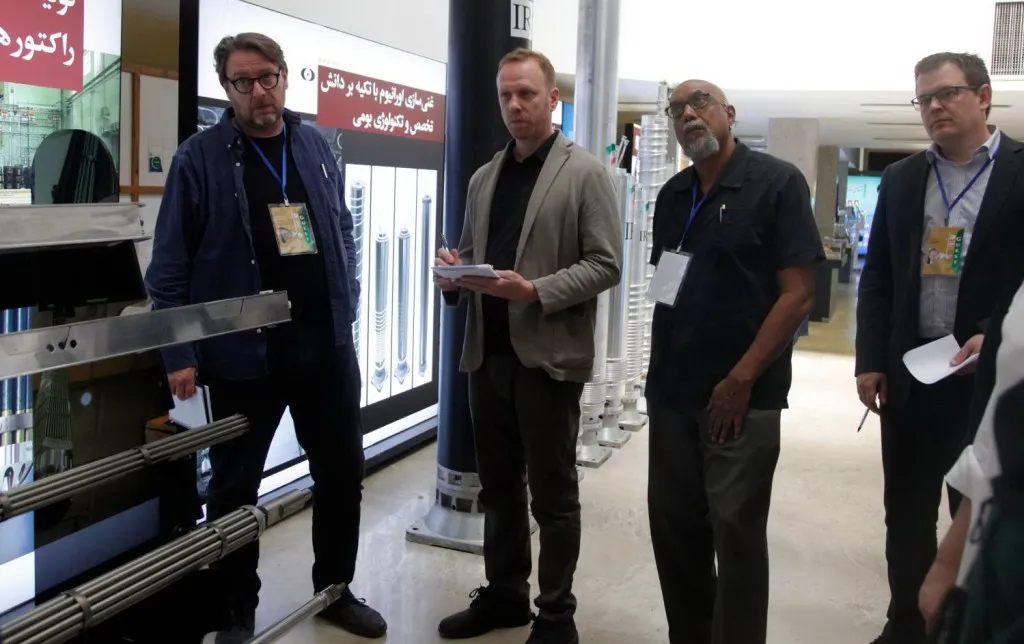
Touring the Tehran Nuclear Research Center this May 2025
Following our tour, we met with Beyrouz Kamalvandi, a veteran Iranian diplomat now serving as spokesman for the AEOI. Like the other Iranian diplomats I spoke to, Kamalvandi volunteered his country’s desire to abide by all its obligations under the Non-Proliferation Treaty. But he viewed Iran’s civilian nuclear program as the key to consolidating its technological edge, and an absolute right under international law.
“They want to do with us what they did with Gaza, where the entire society is besieged,” Kamalvandi proclaimed. “But we have a great civilization, and it’s only a matter of time before they realize we won’t submit. This is not just a battle over enrichment, it’s a battle of wills.”
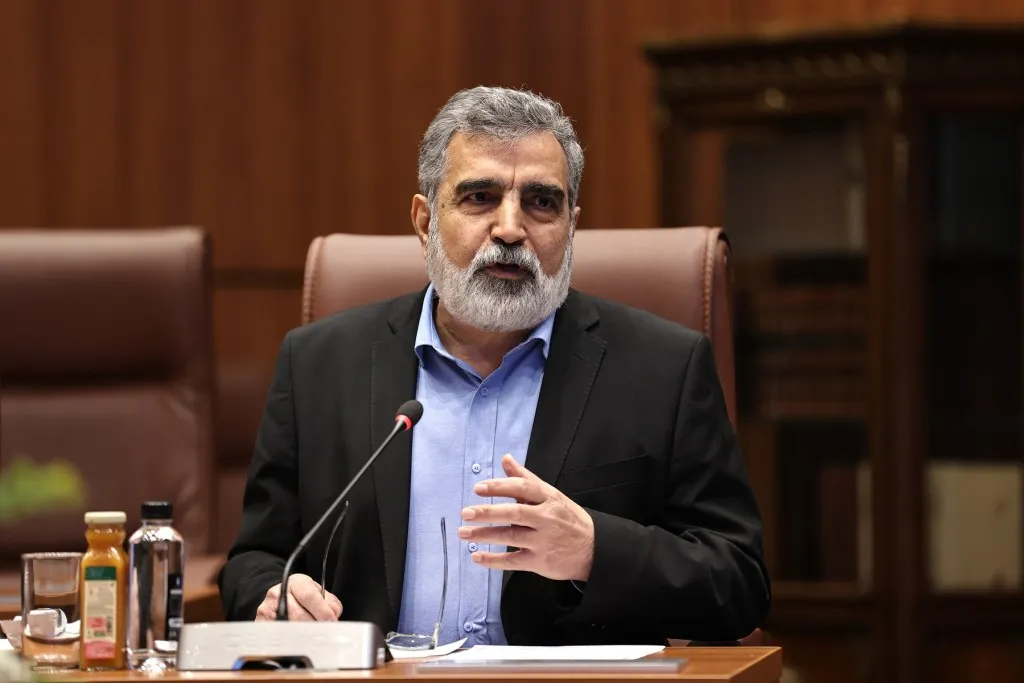
Atomic Energy Organization of Iran spokesman Behrouz Kamalvandi during our tour of the Tehran Nuclear Research Center
At one point during the meeting, Kamalvandi pointed to a young man seated in the back row of the conference room, asked him to stand, and identified him as the son of the Iranian quantum field theorist Massoud Ali-Mohammadi, who was assassinated by a Mossad asset in 2010. Ten years later, Iran lost the godfather of its nuclear program, Mohsen Fakrizadeh, when the Mossad smuggled a machine gun drone into the country and stationed it along a road to attack Fakrizadeh’s convoy. Kamalvandi, for his part, was injured and hospitalized in 2021 while inspecting a part of the Natanz reactor that had been damaged by an Israeli attack.
In the eyes of Iran’s leadership, Witkoff’s demand to end enrichment was not only a recipe for squandering decades of technological advancement, it was an insult to the top tier scientists cut down by Israeli assassins. If this is the new baseline for a deal, negotiations are an exercise in futility. And yet the show goes on.
Economic sabotage behind the guise of negotiations
Since negotiations began, the value of the Iranian rial has fluctuated wildly against the dollar, improving in value after the first round of positive exchanges, then depreciating following each wave of bellicose threats from Trump and his team. I personally witnessed Iran’s financial chaos each time I attempted to exchange dollars for rials, as business owners consulted their phones for the new rate, which seemed to shift from day to day depending on the US president’s rhetoric. A friend joked that I would have paid a substantially lower rate to book a hotel room for my family if negotiations were not currently taking place.
Trump’s statements about the negotiations have also roiled oil markets. On May 16, when Trump claimed he was “getting close to maybe a deal” with Iran, the price of oil plummeted by 3.4%. Then came Witkoff’s call to cease enrichment, and on May 20, US intelligence leaked a warning that Israel was planning to attack Iran’s oil facilities, causing a sudden surge in oil prices.
The American president’s ability to manipulate financial markets both inside and outside Iran with his bluster has contributed to a sense that entering the negotiations have weakened Iran’s political position. Meanwhile, Trump’s crude insults to Iran’s sense of national honor and sovereignty have disrupted whatever goodwill existed when talks began.
The president’s announcement on May 7 that he was considering renaming the Persian Gulf to “the Arabian Gulf” fueled outrage across Iran — uniting everyone from pro-government principlists, to reformists, to pro-regime change monarchists in opposition to the insult to their national pride. Tehran responded with a billboard campaign condemning the change and a lawsuit against Google for abiding by the name change on its Maps applications.

Trump’s speech in Riyadh deepened the enmity, as he attempted to pit the Iranian public against its leadership, praising his unelected, monarchic hosts for supposedly having “turned dry deserts into fertile farmland,” while accusing Iran’s leaders of “turn[ing] green farmland into dry deserts, as their corrupt water mafia…causes droughts and empty riverbeds. They get rich, but they don’t let the people have any of it.”
Two days after Trump’s address in Riyadh, dust storms from the growing deserts of Saudi Arabia gusted into Iran, clouding the skies over Tehran and keeping many residents indoors. The irony did not escape those who heard Trump’s praise for the House of Saud’s supposed green miracle. Meanwhile, there is a growing sense that war clouds are gathering as well.
One well-connected Iranian academic in Tehran told me he expected his country to be on the receiving end of Israeli sabotage and confrontation throughout the summer. Both diplomats I spoke to insisted that in such a scenario, True Promise III was an option on the table.
Reprinted with permission from The Grayzone.
Subscribe and support The Grayzone here. -
Site: LifeNews
U.S. Health and Human Services Secretary Robert F. Kennedy Jr. told the World Health Assembly (WHA) he is calling for a “reboot” of a global health system that will mirror what the Trump administration is implementing through its Make America Healthy Again (MAHA) movement in the US.
In a video message Tuesday to world health ministers gathered in Geneva, Switzerland, Kennedy reviewed the reason President Donald Trump withdrew the US from the World Health Organization (WHO), the health agency of the United Nations (UN), via an executive order on the first day of his new term.
“Like many legacy institutions, the WHO has become mired in bureaucratic bloat, entrenched paradigms, conflicts of interest and international power politics,” Kennedy asserted. “While the United States has provided the lion’s share of the organization’s funding, historically, other countries, such as China have exerted undue influence over its operations in ways that serve their own interests and not particularly the interests of the global public.”
REACH PRO-LIFE PEOPLE WORLDWIDE! Advertise with LifeNews to reach hundreds of thousands of pro-life readers every week. Contact us today.
He also observed that, during the COVID pandemic, the WHO succumbed to pressure from China to suppress reports “of human-to-human transmission” of the virus “and then worked with China to promote the fiction that COVID originated from bats or pangolins rather than from a Chinese government sponsored research at a biolab in Wuhan.”
“Not only has the WHO capitulated to political pressure from China,” Kennedy argued, “it’s also failed to maintain an organization characterized by transparency and fair governance by and for its member states.”
“The WHO often acts like it has forgotten that its members must remain accountable to their own citizens and not to transnational or corporate interests,” he added.
Kennedy continued that, even though he believes most of those who work for the WHO have good intentions, too often “the WHO’s priorities have increasingly reflected the biases and interests of corporate medicine; too often it has allowed political agendas like pushing harmful gender ideology to hijack its core mission; and too often, it has become the tool of politics and turned its back on promoting health and health security.”
Despite the US’ withdrawal from the WHO, President Trump and his administration remain invested in global cooperation on the issue of health, according to Kennedy.
Nevertheless, even with exposure of the corruption behind COVID pandemic policies, the WHO “has doubled down with the pandemic agreement, which will lock in all of the dysfunctions of the WHO pandemic response,” he warned.
“We’re not going to participate in that,” Kennedy asserted. “We need to reboot the whole system, as we are doing in the United States.”
In explaining the Trump HHS’ MAHA agenda, Kennedy said the US will still “focus on infectious disease and pandemic preparedness” but shift its priorities “to focus on chronic diseases, which are prevalent in the United States” and “sickening our people and bankrupting our healthcare system.”
“We’re going to make healthcare in the United States serve the needs of the public, instead of industry profit-taking,” by “removing food dyes and other harmful additives from our food supply,” he said. “We’re investigating the causes of autism and other chronic diseases. We’re seeking to reduce consumption of ultra-processed foods, and we’re going to support lifestyle changes that will bolster the immune systems and transform the health of our people.”
Kennedy said the changes the US is making amount to a “systemic overhaul,” adding that the Trump administration would like to “see a similar reordering of priorities on the global stage, especially considering the fact that through the leadership of the United States and funding from our country, over the past 25 years, millions of global citizens have seen a reduction in premature death due to HIV, TB and malaria.”
The US secretary urged his counterparts in other nations and the WHO “to take our withdrawal from the organization as a wake-up call.”
“It isn’t that President Trump and I have lost interest in international cooperation, not at all,” he said. “We just want it to happen in a way that’s fair and efficient and transparent for all the member states.”
Kennedy also noted the Trump administration has already reached out to other “like-minded countries,” urging others to join them.
“We want a free international health cooperation from the straitjacket of political interference by corrupting influences of the pharmaceutical companies, of adversarial nations and their NGO proxies,” he concluded. “I would like to take this opportunity to invite my fellow health ministers around the world into a new era of cooperation.”
LifeNews Note: Susan Berry writes for CatholicVote, where this column originally appeared.

The post HHS Secretary Robert Kennedy Defends US Leaving WHO appeared first on LifeNews.com.
-
Site: Novus Motus LiturgicusThis is the second installment of a series on the thirteen papal namesakes of our new Holy Father Leo XIV; click these links to read part 1 and part 2. Four Popes named Leo reigned with a span of about 62 years in the 10th century; their reigns are all quite brief, and their careers for the most part so obscure that the precise dates of some of them are not even known, so this will be a short Gregory DiPippohttp://www.blogger.com/profile/13295638279418781125noreply@blogger.com0
-
Site: Zero HedgeOil Prices Dip On Report Of Another Potential OPEC+ Supply BoostTyler Durden Thu, 05/22/2025 - 09:25
OPEC+ is considering a third straight monthly output hike, departing from the norm of stabilizing oil markets. According to Bloomberg, the group of 12 major oil-exporting nations, including Saudi Arabia, UAE, and others, is considering a July increase of 411,000 barrels per day (bpd)—roughly triple the previously planned amount. This would mirror supply increases in May and June. Such an increase in July could lead to a breakdown in Brent crude's $60-per-barrel price floor (as long as the war risk premium remains suppressed).
Brent fell to $63 a barrel, down about 1.7% following the news. West Texas Intermediate dropped to around $60 a barrel.
According to delegates, the increase would mark the third consecutive month of added supply, though they noted that no final agreement had been reached.
Bloomberg provided more color about the strategy at play with OPEC+ that would only increase concerns about a global glut:
The strategy appears aimed at disciplining quota violators by pushing prices lower. But it will add to the overall picture of oversupply -- not only is there a chance of more Iranian barrels hitting the market, energy demand globally looks set to soften.
"We're seeing the market reacting to evidence that OPEC is letting go of a strategy to defend price in favour of market share," said Harry Tchiliguirian at Onyx Capital Group, adding, "It's a bit like taking off a Band-Aid; you do it in one fell swoop."
Department of Energy data released Wednesday morning showed that commercial crude inventories rose for a second consecutive week. Rising inventories and weakness in broader markets have added downward pressure on oil prices.
RBC Capital analyst Helima Croft noted that a 411,000 bpd increase in July is the "most likely outcome," mainly from Saudi Arabia. She said, "A key question will be whether the voluntary cut will be fully drawn down before the leaves turn brown in many parts of the world, in line with the original taper schedule."
OPEC+ is considering another large output increase. However, the macroeconomic backdrop of rising U.S. 10-year Treasury yields may signal a warning: Rising yields reflect tightening financial conditions and slower growth expectations, raising concerns that higher oil supply could weigh on prices. Now, lower prices could be all but derailed if Israel launches a preemptive attack on Iran's nuclear sites with stealth fighters.
-
Site: Ron Paul Institute - Featured Articles
A recent Supreme Court oral argument about the liability of the FBI for invading and terrorizing the wrong home has brought to mind the dark and dangerous history of law enforcement.
The practice of British agents rummaging through the private possessions on the private property of anyone against that person’s will was a significant contributing factor to the American Revolution.
Their most notorious invasion of private property was a subterfuge, perpetrated by the British Parliament, which sought to remind colonists that the king could enter their homes through his agents whenever he wished.
In 1765, Parliament enacted the Stamp Act, which required government stamps — they were actually inked images of government seals, more akin to what is seen when a postage stamp is canceled — on all papers in the possession of the colonists. This included letters, financial and legal documents, newspapers, pamphlets, even posters intended to be nailed to trees. To facilitate the enforcement of the Stamp Act, Parliament enacted the Writs of Assistance Act.
Much like America’s Foreign Intelligence Surveillance Act, the Writs of Assistance Act permitted British agents to obtain search warrants from a secret court for the homes of colonists based on governmental need and without identifying the name or address of the homeowner or even the object sought by the search.
These were general warrants. They were limitless in scope, as they authorized the bearer to search wherever he wished and seize whatever he found. Some students at the College of New Jersey — now called Princeton University — calculated that it cost more for the British government to enforce the Stamp Act than was generated in revenue from the sale of the stamps. We now know that power, not revenue, was the true goal of this dreaded law.
The violent colonial reaction to the enforcement of the Stamp Act led to its repeal by Parliament after just one year. But the Writs of Assistance Act — allowing the London issuance and colonial execution of general warrants — stayed in force until the British left in 1783. And general warrants were not outlawed here until the ratification of the Fourth Amendment in 1791.
The Fourth Amendment was written to protect the quintessentially American right to be left alone. The violation of the right to be left alone usually implicates two fundamental liberties — the right to privacy and the right to own and possess property.
Privacy is a natural right because there are aspects of human existence and personal behavior that are not subject to the government. Natural rights come from our humanity. The natural right to own property has three aspects — the right to use the property, the right to alienate (lease, pledge or sell) it, and the right to exclude whomever the owner wishes — including the government.
As natural rights stem from our humanity, they may only be violated when we give them up or waive them by our violation of someone else’s natural rights. When James Madison wrote the Fourth Amendment, he rejected the waiver standard and instead chose the easier-for-the-government probable cause standard as the sole element justifying a government invasion of property rights.
Today, to get physically — or even digitally — onto your property in defiance of your will, the government theoretically must meet Madison’s probable cause standard.
That standard requires a showing to a neutral judge that it is more likely than not that a crime has been committed and that it is more likely than not that evidence of that same crime can be found in the place to be searched or the person or thing to be seized. These standards come directly from the language of the amendment itself.
Does the probable cause standard adequately protect property rights? It does not; just ask the folks whose home the FBI destroyed.
The probable cause standard involves a weighing and balancing test pitting the nature of property ownership against the government’s claimed need for evidence. It weighs the harm to property rights caused by a government invasion as against the harm to the government by denying it the fruits of its planned invasion.
But the very concept of weighing a natural right against a government need is totalitarian. The government needs whatever it wants, whereas our rights are inalienable unless we waive them. A natural human right always supersedes a government wish. Thus, the only standard that morally justifies a government invasion of private property is waiver by the violation of another’s natural rights.
For example, if a bank robber runs into his house with stolen loot, he has waived his property rights in the house until he has been arrested and the loot retrieved, as he has violated the natural rights of the depositors in the bank and the bank’s right to exclude him from its property. If the government cannot demonstrate waiver by a violation of another’s natural right, then the property owner — even if he is the sought-after bank robber — can morally exclude the government from his property.
Because privacy and property ownership are inalienable rights and the government is an artificial creation based on a monopoly of force, when the government wants to enter upon private property against the will of the owner, and it seeks a warrant from a judge, the owner’s natural rights and the government’s needs can never be in equipoise.
Even when the government seeks to demonstrate waiver, the government should be presumed to be wrong, and every inference and bias should be drawn against it because the essence of government is the negation of liberty. We were born with natural rights. The government’s only source of wealth and power is what it has been taken from us.
Regrettably, none of this is the law today as the Constitution is a demonstrable failure. Today we are back to search wherever you wish and seize whatever you find.
To learn more about Judge Andrew Napolitano, visit https://JudgeNap.com.
COPYRIGHT 2025 ANDREW P. NAPOLITANO
DISTRIBUTED BY CREATORS.COM -
Site: Zero HedgeDeath Of The Dollar: An Eternal TaleTyler Durden Thu, 05/22/2025 - 09:05
Authored by Michael Lebowitz via RealInvestmentAdvice.com,
The following paragraph, courtesy of Amazon, reviews the book Death of the Dollar by William Rickenbacker.
Death of the Dollar by William F. Rickenbacker is a critical examination of the economic policies and monetary mismanagement that the author argues are eroding the value of the U.S. dollar and threatening financial stability. Rickenbacker contends that the actions of money managers, including excessive government spending, inflationary policies, and the detachment of the dollar from the gold standard, are systematically devaluing the currency. The book warns of an impending monetary disaster, highlighting how these policies disproportionately harm everyday citizens who rely on the dollar’s stability for savings and investments. Through a blend of economic analysis and historical context, Rickenbacker underscores the dangers of unchecked financial intervention and the potential for a collapse of the dollar’s purchasing power.
Plenty of books, articles, and social media posts herald the same grim forecast as Rickenbacker. For the most part, they rely on similar reasoning. Essentially, lax monetary policy and gross fiscal spending, both deemed to be inflationary, will result in dollar devaluation and ultimately the death of the dollar.
The difference between Rickenbacker’s book and other dollar demise forecasts is that Death of the Dollar was written in 1968! Fifty-seven years later, despite, or possibly because of Rickenbacker’s justifications, the dollar is still the world’s reserve currency, and no other sovereign currency, cryptocurrency, or precious metal will replace it anytime soon.
Given the topic’s importance and the gross misinformation spread about the dollar’s imminent demise, we review Rickenbacker’s thesis to highlight that today’s warnings have been around for decades and why the odds of them coming to fruition this time are very low, as they were decades ago.
Removal Of The Gold Standard
Rickenbacker’s book was published in 1968, three years before President Nixon closed the gold window, essentially making the dollar a fiat currency. While his book accurately predicted that ground-shaking event, it did not correctly anticipate its impact.
He reasoned that without gold regulating the supply of dollars, unchecked monetary policy would result in reckless “money printing.”
He was correct that the Fed would have more flexibility in managing the money supply. Furthermore, with this added power, we have seen reckless behavior, as he theorized. However, Rickenbacker erred on the money printing allegation.
The Fed doesn’t print money. All money is lent into creation by banks. The Fed prints bank reserves, which allow banks to make loans, i.e., print money, if they choose. More importantly, even if the money supply increases due to Fed incentives to lend, it’s unclear whether such activity is good or bad for the economy and how it impacts inflation and ultimately the dollar’s value. That is a function of the productivity of debt.
Simply, productive debt drives economic growth, increases the nation’s prosperity, and reduces deficits as a percentage of economic activity. Unproductive debt detracts from economic growth and prosperity and worsens deficits. Weaker growth from unproductive debt tends to be disinflationary.
As judged by an increasing debt-to-GDP ratio, aggregate debt has been unproductive, leading to lower inflation growth rates. Thus, if the concern is that “money printing” would lead to inflation, it may lead to disinflation.
Fed Flexibility
In one respect, Rickenbacker correctly said that giving the Fed more flexibility was a curse. Easy money policy has led to periods of gross speculation and crises, such as in 2008.
However, without the gold shackles, the Fed has incredible power to manage economic crises and avoid a currency collapse. In fact, despite the 2008 crisis having roots in the US mortgage market and the prospect of the collapse of the US banking system, the world flocked to dollars during the crisis, as shown below.
Most crises have been accompanied by a stronger dollar, proving that the dollar is the port in the storm foreign investors seek when economic confidence is lacking, and liquidity is paramount.
Excessive Government Spending
The book criticizes massive federal expenditures, particularly on social programs and military efforts, which create budget deficits, drive up inflation, and ultimately devalue the dollar. The book was written while Lyndon Johnson spent heavily on the Vietnam War and domestic programs. Again, Rickenbacker was correct in worrying about inflation, a big problem throughout the 1970s.
Despite ever-increasing government spending and an increasing debt-to-GDP ratio, the globalization of trade has expanded rapidly since his book was published. With it, foreigners’ demand for dollars has been growing, and in mirror fashion, so is their need to invest the dollars, which helps us fund our deficits.
Even today, with “runaway” deficits making headlines daily, the dollar remains in the upper range of the last 35 years.
Dollar Devaluation In Context
Rickenbacker believed that easy money Federal Reserve policies, such as low interest rates and expanding the money supply, would fuel inflation that would erode the dollar’s purchasing power. He was right, as evidenced by comparing what a dollar buys today versus yesteryear. However, the argument provides little context.
For instance, in the 1950s, a hamburger (15 cents), fries (10 cents), and a Coke (10 cents) at McDonald’s cost less than 50 cents. Today, the same meal could run nearly $10.
Although decades of inflation have drastically eroded the dollar’s value, our standard of living has risen appreciably. To wit, the purchasing power of one dollar in 1947 has eroded to 7 cents. However, as shown below, inflation-adjusted incomes have risen fivefold since 1947. The dollar buys less, but our incomes buy more!
Trade and Balance of Payments Deficits
Rickenbacker points to persistent U.S. trade deficits and dollar outflows abroad, which weaken the currency’s global standing. He is correct that trade deficits have steadily increased, resulting in more dollars flowing abroad. However, more dollar outflows are a result of more demand for dollars. Furthermore, those dollars ultimately return to the US through investments and loans to the government and corporations. The larger the global economy, the greater the need for dollars, and the more dollars that need to be invested in the US economy.
Rickenbacker Was Right
The author’s concerns are valid and, in many cases, have proven true. However, the victim has not been the dollar. The victims are larger deficits, lower productivity growth, hollowing out of manufacturing, and a growing wealth divide, to name a few.
While these are big problems, they do not necessarily threaten the dollar’s status. As we wrote in Four Reasons The Dollar Is Here To Stay:
The pundits will be right someday. The dollar’s death as the reserve currency will come, and some other nation’s currency, cryptocurrency, gold, shells, or something else will take its place. However, that day is not coming anytime soon. The four reasons we describe in the article leave the world with no alternative.
While China is rapidly growing its economy and global trade footprint, it lacks the rule of law and liquid capital markets to sustain a global currency. It’s difficult to see how a communist country can overcome those challenges.
The Euro is the most viable competitor. They have the rule of law, but their capital markets are not nearly liquid enough to facilitate global trade. They also lack the military might to force the usage of the Euro. Let us also remember its finances are in equally bad or even worse shape than the U.S. There is no reason to suspect the euro could overtake the dollar.
Bitcoin? Forget about it! The government will never relinquish its control over the currency because, with that, they lose control of the nation.
Summary
Had Rickenbacker’s Death of the Dollar book solely focused on monetary and fiscal imprudence and its negative implications for the country, he would have been proven a seer. Unfortunately, he was wrong to insist that the dollar would lose its status as the world’s reserve currency.
The graph below, courtesy of the Federal Reserve, shows how the dollar’s usage in global transactions has been stable for the last two decades.
The index calculation, as detailed at the bottom of the graphic, is based on the primary uses of currencies.
-
Site: Mises InstituteGovernment protection and deposit insurance slows the inevitable—until it doesn’t.
-
Site: AsiaNews.itIn his first visit to Lebanon since 2017, the Palestinian president is committed to disarmament, although without setting a timetable. This complex process is seen in Beirut as a prerequisite for the total end of Hezbollah's armed struggle. The joint statement with President Aoun includes an 'implicit' recognition of Israel's right to exist.
-
Site: Zero HedgeDOGE Damage Deepens As 'Deep TriState' Continuing Jobless Claims Highest Since Dec 2021Tyler Durden Thu, 05/22/2025 - 08:51
The number of Americans filing for jobless benefits for the first time fell modestly last week to 227k (below expectations) and is basically unchanged since December 2021...
...despite the public sentiment panic by CEOs, layoffs refuse to rise (is all that whining just signaling how much virtue they have, or is it like UMich, damaged by TDS in their imaginations, but not enough to impact the real world)...
Continuing jobless claims pushed back above the critical 1.9 million Americans level once again...
...as while the private sector CEOs seem to refuse to budge (despite their misery), the 'Deep Tristate' is seeing continuing jobless claims surge to the highest since December 2021...
DOGE is working!!
-
Site: Zero HedgeFutures, Treasuries Slide After "Big, Beautiful Bill" PassesTyler Durden Thu, 05/22/2025 - 08:41
US stocks and treasuries sold off after President Trump’s signature tax bill passed the House by the narrowest of margins (214-215), sparking fears that the surging deficit - already at a nosebleed 6.5% of GDP - necessary to fund the bill will spark even higher rates at a time when foreign buyers are boycotting US Treasury purchases. As of 8:00am, S&P futures slumped by 0.5%, trading near session lows and reversing an earlier gain of about 0.3%. Nasdaq futures dropped 0.4%. Treasuries also slumped, extending days of losses in which the 30-year yield hit the highest since 2023: the 10Y was trading at session highs of 4.62%. The dollar ended a three-day losing run while Bitcoin pushed further into record territory. Commodities are weaker across all 3 complexes: oil slumped again after BBG reported that OPEC+ is considering another production hike at the June 1 meeting. SCMP reports that Mexico pledges neutrality between US/China in the Trade War; this follows a similar announcement from Indonesia last month. Today’s macro data focus is on Flash PMIs, weekly claims, existing home sales, and regional Fed activity indicators.
In premarket trading, Mag 7 stocks were mixed (Alphabet +1.2%, Nvidia +0.5%, Amazon +0.5%, Tesla -0.2%, Meta Platforms +0.3%, Microsoft +0.02%, Apple -0.1%). Solar stocks sink as US House Republicans’ new version of the tax and spending bill accelerates the end of incentives for clean electricity production (Sunrun -34%, Array Technologies -14%, First Solar -6%). Crypto-linked stocks gained in premarket trading after Bitcoin hit an all-time high. The world’s largest cryptocurrency reached a record price of $111,878 on Thursday amid growing optimism around the US stablecoin bill (Galaxy Digital (GLXY) +5%, Riot Platforms (RIOT) +3%, Mara Holdings (MARA) +3%). Here are some other notable premarket movers:
- Advance Auto Parts (AAP) soars 30% after the retailer of aftermarket auto components reaffirmed its comparable sales forecast for the full year.
- Analog Devices (ADI) rises 2% after the chipmaker reported adjusted earnings per share for the second quarter that beat the average analyst estimate.
- Delcath Systems (DCTH) rises 2% after the specialty pharmaceutical and medical devices company issued full year 2025 guidance and announced a plan to enter into a National Medicaid Drug Rebate Agreement to expand patient access.
- Nike (NKE) shares rose in premarket trading as the company returns to Amazon.com’s online store after leaving it in 2019.
- Humana (HUM) falls 5% and UnitedHealth Group (UNH) slips 2% after the Centers for Medicare & Medicaid Services said it will embark on a “significant expansion” of its auditing efforts for Medicare Advantage plans.
- LiveRamp (RAMP) climbs 10% after the marketing technology company reported fourth-quarter results that beat expectations.
- Lumen Technologies (LUMN) advances 12% after AT&T agreed to buy the company’s consumer fiber operations for $5.75 billion, expanding its fast broadband service in major cities like Denver and Las Vegas.
- Manchester United (MANU) drops 5% after the English football club lost the high-stakes Europa League final to Tottenham Hotspur in Bilbao, Spain last night.
- Navitas Semiconductor (NVTS) surges 175% after the semiconductor company said Nvidia picked it to collaborate on data center power infrastructure.
- Sable Offshore Corp. (SOC) falls 4% after the oil and gas company priced its stock offering.
- Snowflake (SNOW) gains 9% after the software developer forecast product revenue for the second quarter above the average analyst estimate.
- Urban Outfitters (URBN) rises 18% after the apparel retailer reported net sales for the first quarter that beat the average analyst estimate.
Just before 7am ET, after an all night session in the House, US lawmakers passed Trump's "big, beautiful bill", a sprawling multi-trillion dollar package that would avert a year-end tax increase at the expense of adding to the US debt burden. The move comes after a downgrade by Moody’s Ratings thrust concerns over the ballooning deficit into the spotlight. This has shown up in Treasuries, sapping sentiment after an equity rebound put the S&P 500 on the cusp of a bull market. Goldman calculated the yield at which stocks would crack: the bank notes that on May 1st, 10yr yield was 4.12%...we just touched 4.6% yesterday after the weak 20yr auction. At what level do yields start to put real pressure on the stock market? The easy big round number is 10yr @ 5%. The more nuanced answer is >4.7% (before the end of May) as velocity of move in rates matters much more than absolute levels (in regards to impacting stocks). When 10yr yield has moved higher by 2SD (60bps) within a one month period the stock market comes under pressure.
“Bond vigilantes are back,” Beata Manthey, a strategist at Citigroup Inc., told Bloomberg TV. “The market is worried about debt sustainability. It’s not very helpful, given how strong a rebound we’ve been seeing in equity markets.”
Later on Thursday, S&P Global will issue its preliminary May survey of manufacturing and service providers. Based on economists’ projections, industrial weakness probably continued while growth in services activity may have picked up slightly. Weekly jobless claims data is also due.
Meanwhile, the doom and gloom from Jamie Dimon continued, after the JPMorgan CEO said he can’t rule out the US economy will fall into stagflation as the country faces huge risks from both geopolitics, deficits and price pressures. “I don’t agree that we’re in a sweet spot,” Dimon told Bloomberg TV in Shanghai.
With everything else being sold, traders turned to non-fiat alternatives: Bitcoin surpassed $111,000 for the first time with traders increasingly bullish on the prospects of the cryptocurrency., gold traded back over $3,300.
“Bitcoin, and the crypto market in general, have largely decoupled from equities over the last few days,” said Richard Galvin, co-founder of hedge fund DACM. “Bitcoin continues to benefit from its market position as a non-system, store of value.”
European stocks fall as worries over rising bond yields curbed investor appetite for risky assets. The Estoxx index slumped 1%, with the yield-sensitive technology sector is among the biggest laggards. Among individual stocks, EasyJet Plc falls after the low-cost airline reported bigger-than-expected losses, while Johnson Matthey rises on a major sale of its technology business. Here are some of the biggest movers:
- Johnson Matthey shares jump as much as 34%, the most in over three years, after the company announced the sale of its catalyst technology business at an enterprise value of £1.8 billion, with the bulk of proceeds to be returned to shareholders.
- Mitchells & Butlers gains as much as 2.2% after the pub and restaurant operator delivers what analysts view as a strong update, with full-year operating profit expected to be at the top end of current consensus.
- Grenergy Renovables gains as much as 8%, hitting a new record high. RBC Capital says the Spanish renewables company has achieved strong growth in the first quarter, supported by gains of the Atacama storage project.
- Gimv gains as much as 8.9%, the most since March 2020, after the investment company posts what KBC Securities describes as another record year
- Stora Enso gains as much as 7% to its highest since March 20 after the Finnish forest and paper company said it will divest around 175,000 hectares of forest land in Sweden for a total value of €900 million.
- EasyJet shares fall as much as 6.1% after the travel firm reported a loss in the first half.
- BT shares drop as much as 5.3% after the telecom company reported a decline of 243,000 Openreach broadband lines in the quarter ended March, a sign of heightened competition among UK’s fiber builders.
- British Land shares drop as much as 7.1% in their worst one-day loss in two years, after the UK property firm’s unchanged guidance and forecast for flat 2026 earnings per share tempered a recent rally in the stock.
- Freenet shares sink as much as 16%, the most since May 2022, after the mobile communications service provider reported Ebitda for the first quarter that missed estimates.
- Elior drops as much as 5.3% following a mixed first-half report from the commercial catering company.
- Intertek shares drop as much as 3% after the inspection services provider reported disappointing organic growth for the first four months of the year.
- MPC Container Ships falls as much as 17%, the most since 2021, after the Norwegian shipping firm presented its latest earnings and a new dividend policy.
Asian equities dropped the most in two weeks, driven by losses in technology stocks after Treasury yields jumped overnight on concerns about the US budget deficit. The MSCI Asia Pacific Index fell as much as 0.8%, the biggest decline since May 8, with Alibaba, TSMC and Samsung contributing the most to the losses. South Korea’s Kospi retreated over 1%, while benchmark gauges in Hong Kong, Japan and India also lost ground. Philippine stocks weakened after President Ferdinand Marcos Jr. ordered his cabinet to resign.
In FX, the Bloomberg Dollar Spot Index rebounded to rise 0.1% after three straight days of losses. EUR/USD fell 0.2% to 1.131 after data showed private-sector activity in the euro area unexpectedly shrank in May. USD/JPY slumped as much as 0.6% to 142.81, the lowest level in two weeks, before paring the move to trade 0.2% lower. Despite the latest drop, the Hang Seng China Enterprises Index remains on track to cap a sixth straight week of gains. JPMorgan Chase is committed to long-term investment in China, despite tensions with the US, Chief Executive Officer Jamie Dimon said in a Bloomberg TV interview.
In rates, the yield for 10-year Treasuries advanced two basis points to 4.62% on Thursday. The worry in debt markets is that the tax bill would add trillions of dollars to an already bulging deficit at a time when investors’ appetite is US assets is slumping. The 30-year yield reaching new multimonth highs of 5.15% while short-end tenors richen, pivoting around a little-changed 7-year sector. 5s30s spread near 97bp is widest since May 1. European sovereign curves are also steeper. The Treasury will sell $18 billion of 10-year TIPS in a reopening at 1pm New York; Wednesday’s 20-year new-issue auction tailed by about 1bp, spurring long-end yields higher. Focal points include House Republicans narrowly passing President Trump’s tax bill shortly before 7am, PMI and jobless claims data, a 10-year TIPS auction and comments by NY Fed President Williams.
Looking at today's calendar, US economic data includes April Chicago Fed national activity index and weekly jobless claims (8:30am), May preliminary S&P Global US PMIs (9:45am), April existing home sales (10am) and May Kansas City Fed manufacturing activity (11am). Fed speaker slate includes Richmond Fed President Barkin (8am) and Williams (2pm).
Market Snapshot
- S&P 500 mini -0.5%
- Nasdaq 100 mini -0.4%,
- Stoxx Europe 600 -1%
- DAX -0.8%, CAC 40 -1%
- 10-year Treasury yield -2 basis points at 4.58%
- VIX -0.4 points at 20.49
- Bloomberg Dollar Index +0.1% at 1220.46
- euro -0.3% at $1.1297
- WTI crude -1.5% at $60.66/barrel
Top Overnight News
- A man fatally shot two Israeli Embassy staff members late Wednesday near a Jewish museum in downtown Washington. WSJ
- Scott Bessent and his Japanese counterpart Katsunobu Kato confirmed existing currency views and didn’t discuss FX levels when they met in Canada. BBG
- On a call Monday, President Trump told European leaders that Russian President Vladimir Putin isn’t ready to end the Ukraine war because he thinks he is winning. This runs counter to what Trump has often said publicly, that he believes Putin genuinely wants peace. WSJ
- BOJ board member Asahi Noguchi said on Thursday he saw no need for the central bank to intervene in the bond market to stem recent sharp rises in super-long yields, describing the moves as "rapid but not abnormal." Noguchi also said the central bank must pause its interest rate hikes for the time being until there is more clarity on the impact of U.S. tariffs on the economy. RTRS
- Israel is making preparations to “swiftly” strike Iran’s nuclear facilities if talks between Washington and Tehran collapse without a deal. Axios
- OPEC+ members are discussing whether to agree on another super-sized production increase at their meeting June 1, delegates said. That would be the third straight month of adding more barrels to the market. Oil declined. BBG
- Eurozone flash PMIs for May were mixed, with modest upside on manufacturing (49.4, up from 49 in Apr and above the Street’s 49.2 forecast) and slight downside on services (48.9, down from 50.1 in Apr and below the Street’s 50.5 forecast), while inflation in aggregate cooled (driven by manufacturing). S&P
- US/EU trade talks – Brussels is offering to extend an existing shellfish trade deal w/the US that expires on 7/31 as an inducement to striking a broader agreement around tariffs. FT
- Lutnick says he predicts a slew of trade deals by the middle of the summer and doesn’t anticipate tariffs fueling higher prices in the US. Axios
- BofA Institute Total Card Spending (Week to 17th May) -0.7% (vs +1.0% average in April)
- US President Trump posted "I am giving very serious consideration to bringing Fannie Mae and Freddie Mac public. I will be speaking with Treasury Secretary Scott Bessent, Secretary of Commerce Howard Lutnick, and the Director of the Federal Housing Finance Agency, William Pulte, among others, and will be making a decision in the near future."
Trade/Tariffs
- EU is open to extending lobster deal as part of a package to remove tariffs imposed by US President Trump, according to FT.
- South African President Ramaphosa said following a meeting with US President Trump that they had discussions on trade and there will continue to be engagement on tariffs. It was also reported that South Africa's Trade Minister said they submitted a proposal regarding a framework agreement with the US and had some US feedback, while they then resubmitted a revised document with the proposal about a trade agreement.
- Canada's Minister of International Trade and Intergovernmental Affairs LeBlanc is to visit Washington DC to meet with Trump admin officials, while it was also reported that Canada's Finance Minister Champagne said he will discuss Canada's role as the largest customer for US exports in meeting with US Treasury Secretary Bessent.
- Japanese Finance Minister Kato said he told Bessent that US tariffs are regrettable and stated tariffs are not an appropriate means to correct macroeconomic imbalances that are behind trade imbalances, while Kato noted that he did not directly discuss Japan's US Treasury holdings in the meeting with Bessent.
- US Treasury Secretary Bessent and Japanese Finance Minister Kato discussed global security and bilateral trade and currency issues on the sidelines of the G7, while they reaffirmed shared belief that exchange rates should be market-determined and reaffirmed USD/JPY exchange rate currently reflects fundamentals.
A more detailed look at global markets courtesy of Newsquawk
APAC stocks were on the back foot following the sell-off on Wall St where stocks, treasuries and the dollar were pressured amid deficit concerns and a weak 20-year auction. ASX 200 retreated with energy and tech front-running the declines, although continued strength in gold producers atoned for some of the losses. Nikkei 225 gapped beneath the 37,000 level amid a firmer currency and proceeded in a somewhat choppy fashion as participants also digested data releases, including a surprise surge in Japanese Machinery Orders and mixed PMI figures. Hang Seng and Shanghai Comp conformed to the downbeat sentiment in the absence of any fresh bullish catalysts and after recent earnings results failed to inspire, while the mainland initially showed resilience in early trade before succumbing to the broad risk-off mood.
Top Asian News
- PBoC to sell CNY 500bln of one year medium term lending facility loans on Friday.
- RBA's Hauser, on recent trip to China, says found confidence Beijing would do what was needed to sustain growth; Australian exporters upbeat about resilience of China demand Found striking confidence that China going into trade war with strong hand. China organisations expected large share of economic costs of tariffs would fall on US. China contacts expressed a determination not to cushion those costs. Found little expectation that yuan would be devalued to insulate US from tariffs. Possible could see more intense competition at home from Chinese firms discounting. Unclear how big an impact given limited overlap between Chinese and Australian output.
- BoJ's Noguchi says they do not look at the size of JGB buying from the standpoint of monetary policy. In tapering, market predictability and flexibility is the most important. Does not think it is appropriate to recklessly intervene to correct bond yield moves. Should not move on rates when there is a lack of clarity on economic outlook.
- Japanese Economy Minister Akazawa held unofficial phone talks with US Treasury Secretary Bessent before Wednesday, according to TV Tokyo; Bessent reportedly expressed reluctance to meet Akazawa this week; the two will meet next week instead.
- China's MOFCOM says China firmly opposes US export controls on Chinese AI chips.
European bourses (STOXX 600 -0.7%) opened lower across the board, in a continuation of the pressure seen on Wall St/APAC trade and have traded at subdued levels throughout the morning. European sectors hold a strong negative bias, with only Basic Resources and Chemicals marginally holding in positive territory. Consumer Products is underperforming after LVMH’s (-1.5%) cautious comments on the Luxury sector. Chemicals names are faring better vs peers, with Bayer (+1.7%) doing much of the heavy lifting. The Co. benefits from a WSJ report which suggests the US HHS Secretary's move will “go easier than expected on pesticides in farming”.
Top European News
- ECB's Nagel sees progress on the US tariff dispute but more hurdles to overcome and noted the US was showing a better understanding of Europe's point of view, while he is a little more confident than perhaps was a few days ago. Nagel stated that German economic growth in Q1 could surprise on the upside but will get worse in Q2 and could see 1% plus growth in 2026.
- ECB's Vujcic says "Euro area growth is positive but low; inflation is slowly converging to 2% target; expect to get close to 2% target at end-2025" Expect to reach 2% target in early 2026.
- IMF forecasts French growth of 0.6% in 2025 and 1% in 2026; says France needs fiscal effort of 1.1% of GDP in 2026, followed by an average of about 0.9% over the medium term; Says France needs credible and well-designed package of measures to rein in deficit over time.
- EU Parliament backs very high tariffs on nitrogen-based fertilisers and farm produce from Russia and Belarus.
Eurozone PMIs
- EU HCOB Composite Flash PMI (May) 49.5 vs. Exp. 50.7 (Prev. 50.4); HCOB Services Flash PMI (May) 48.9 vs. Exp. 50.3 (Prev. 50.1); HCOB Manufacturing Flash PMI (May) 49.4 vs. Exp. 49.3 (Prev. 49.0)
- French HCOB Composite Flash PMI (May) 48.0 vs. Exp. 48.0 (Prev. 47.8); HCOB Services Flash PMI (May) 47.4 vs. Exp. 47.5 (Prev. 47.3); HCOB Manufacturing Flash PMI (May) 49.5 vs. Exp. 48.9 (Prev. 48.7)
- German HCOB Composite Flash PMI (May) 48.6 vs. Exp. 50.4 (Prev. 50.1); HCOB Services Flash PMI (May) 47.2 vs. Exp. 49.5 (Prev. 49.0); HCOB Manufacturing Flash PMI (May) 48.8 vs. Exp. 48.9 (Prev. 48.4)
- UK Flash Composite PMI (May) 49.4 vs. Exp. 49.3 (Prev. 48.5); Flash Services PMI (May) 50.2 vs. Exp. 50.0 (Prev. 49.0); Flash Manufacturing PMI (May) 45.1 vs. Exp. 46.0 (Prev. 45.4)
FX
- USD is currently relatively steady and mixed vs. peers following three consecutive sessions of losses. With trade updates lacking, focus is currently on the fiscal front as markets await the outcome of the House vote on President Trump's tax bill. If the bill passes this hurdle, attention from an FX perspective will be on how back-end US rates react to the price tag and impact on the deficit. This week's data highlights are presented today via weekly claims and flash PMI metrics. The latter will likely carry greater sway as markets look for evidence on how the trade war is impacting US business. Fed speaker's today include Williams and Barkin.
- The rally in the EUR has paused for breath. This morning's macro focus has been on EZ PMI metrics which have painted a picture of a stabilising manufacturing sector but a slowdown in the services industry. The trade war is clearly acting as a cloud over the Eurozone economy; note, yesterday Bloomberg reported that the EU is preparing a trade proposal for the US to steer momentum into talks. Today's docket sees the ECB's account of the April meeting. Currently trading around the 1.13 mark.
- JPY is top of the G10 leaderboard alongside the soft risk sentiment and as markets digest comments from Japanese Finance Minister Kato and BoJ board member Noguchi. On the former, Kato noted that he agreed with US Treasury Secretary Bessent that FX rates should be set by markets and they did not directly discuss Japan's US Treasury holdings. Elsewhere, BoJ's Noguchi, in response to recent moves in Japanese yields, said that he does not think it is appropriate to recklessly intervene to correct bond yield moves.
- GBP is a touch firmer vs. the USD and extending its winning run for a fourth consecutive session. The latest round of PMI metrics from the UK saw the services component beat expectations and return to expansionary territory, manufacturing missed but ultimately, the composite rose and just about beat the consensus. Looking ahead, today's speaker slate sees a trio of MPC members with Breeden, Dhingra & Pill all due on deck. Cable is currently contained within Wednesday's 1.3380-1.3468 range.
- Mildly diverging fortunes for the Antipodes with AUD outperforming NZD as the AUD/NZD cross looks to close the post-RBA gap lower. Incremental newsflow for both has been lacking as the New Zealand Budget and forecasts garnered little fanfare and comments from RBA's Hauser proved to be non-incremental.
Fixed Income
- USTs are a little firmer, attempting to recover following the hefty losses seen in the prior session following a weak US 20yr auction. Focus firmly is on the fiscal front. Overnight, the House Rules Committee passed President Trump’s tax/spending bill. Thereafter, the broader floor voted to open debate on the tax bill, a debate process that lasts for around two hours (started approx. 08:00BST) and is followed by a vote on the bill. Progress on the bill is bearish for USTs as it will increase the US’ debt level, a figure which has been increasing and was the driver behind the Moody’s downgrade last week. USTs currently trading around 109-19.
- Bunds started the day in the red but currently at the upper-end of a 129.49-91 band. Bunds have been gradually making their way off lows throughout the morning, edging higher slowly into the day’s data points which have featured generally weak Flash PMIs, with the expectation of Manufacturing where tariff-mitigation measures appear to have provided some support. No real reaction to the German Ifo figures at the same time. Ahead, ECB Minutes though as usual these will be deemed stale; focus will be on ECB's de Guindos, Elderson and Escriva throughout the day.
- Gilts are softer, trading slightly weaker than EGBs throughout the morning as has been the case at several points over the last few weeks but with today’s underperformance likely a function of Gilts reacting to Wednesday’s US auction and borrowing data this morning. PSNB data this morning came in well above expectations and the prior, though that was subject to a downward revision, in another unwelcome series for Chancellor Reeves after the hotter-than-expected inflation print earlier this week. Given all this, Gilts opened lower by 18 ticks and then slipped another 13 to a 90.29 trough in short order.
- Swedish Debt Office sees the 2025 deficit at SEK 93bln (Nov. forecast 65bln), nominal bond volume SEK 118bln (Nov. forecast 100bln); "new plan also contains an additional foreign currency bond for this year".
- Spain sells EUR 6.2bln vs exp. EUR 5.5-6.5bln 5.15% 2028, 3.10% 2031 & 1.00% 2042 Bonds.
- France sells EUR 12.497bln vs exp. EUR 10.5-12.5bln 2.40% 2028, 2.70% 2031, 0.00% 2032 OATs.
Commodities
- Crude futures were pressured overnight by the downbeat mood across markets and following bearish inventory data. Renewed pressure was seen during the European morning amid source reports that OPEC+ members are reportedly discussing whether to agree to another output hike of 411k BPD in July, via Bloomberg citing sources, although no agreement has been reached yet. WTI resides in a USD 60.37-61.75/bbl range while its Brent counterpart trades in a USD 63.67-65.03/bbl parameter.
- Overall, there is mixed trade across precious metals with hefty underperformance in spot palladium as it tracks the downbeat sentiment across the auto sector. Spot gold trades flat now and currently resides in a current USD 3,311.08-3,345.47/oz range.
- Base metals are mostly lower amid the broader downbeat risk profile, whilst Flash PMIs from Europe this morning were mixed but the commentary was mostly downbeat. 3M LME copper resides closer to the bottom end of a USD 9,495.65-9,579.20/t range at the time of writing.
- UK urged lowering price cap on Russian oil at the G7 meeting, according to Bloomberg.
- OPEC+ members are reportedly discussing on whether to agree to another output hike of 411k BPD in July, via Bloomberg citing sources; one of the options being discussed, no agreement has been reached yet.
Geopolitics: Middle East
- Iranian Foreign Minister says "We have a better understanding in many areas, but in some, especially enrichment, differences still remain. I think we cannot reach an agreement until this issue is resolved.", via Iran Nuances
- Israel is preparing to carry out a swift attack on Iran's nuclear facilities if nuclear talks between the US and Iran fail, via Walla citing sources.
- Israeli military said it identified and intercepted a missile launched from Yemen towards Israel.
- Two Israeli embassy employees were killed in a shooting near a Jewish museum in Washington DC, while the Washington DC police chief announced the suspect was detained by event security and had chanted "Free Palestine" while in custody.
Geopolitics: Ukraine
- Moscow Mayor says Russian has downed two drones en route to Moscow
- US President Trump told European leaders in private that Russian President Putin isn't ready to end the war, according to WSJ.
Geopolitics: Other
- North Korea said it will convene the ruling party central committee meeting in late June and North Korean leader Kim watched the launch of a 5000-ton destroyer, while an accident occurred during the launch of the North Korean warship. Furthermore, Kim said the accident was unacceptable and was the result of negligence and irresponsibility.
- Indian PM Modi says Pakistan will not get water, to which India has a right.
US Event Calendar
- 8:30 am: Apr Chicago Fed Nat Activity Index, est. -0.25, prior -0.03
- 8:30 am: May 17 Initial Jobless Claims, est. 230k, prior 229k
- 8:30 am: May 10 Continuing Claims, est. 1881.62k, prior 1881k
- 9:45 am: May P S&P Global U.S. Manufacturing PMI, est. 49.85, prior 50.2
- 9:45 am: May P S&P Global U.S. Services PMI, est. 51, prior 50.8
- 9:45 am: May P S&P Global U.S. Composite PMI, est. 50.3, prior 50.6
- 10:00 am: Apr Existing Home Sales, est. 4.1m, prior 4.02m
- 10:00 am: Apr Existing Home Sales MoM, est. 1.99%, prior -5.9%
DB's Jim Reid concludes the overnight wrap
Morning from Holland where I’ve just been told I’m now a BA Gold Card holder for life after my latest trip tipped me over the landmark. Annoyingly in my first 10 plus years of my career I didn’t collect tier points as I couldn’t be bothered to fill in the forms. So what could have been. I’ll make sure that on my way back home today I’ll have a celebratory decaf latte in the lounge.
If you collected air miles for issuing government debt then many DM countries would have been in the first class lounge many years ago and over the last 24 hours concerns have continued to mount about debt sustainability. We should put it into some perspective as sensible people have been worried about debt sustainability for years. Indeed if you'd have told anyone 10-20 years ago that the US could comfortably fund 7% mid-cycle deficits in recent years then most would have been incredulous at the prospect. So we could have sustainability fears for years to come before an inevitable accident or event happens. However it's fair to say that events in 2025 have brought forward any day of reckoning.
Yesterday saw the 30yr Treasury yield (+12.3bps to 5.09%) close above 5% for the first time since October 2023, and only 2bps away from its highest level since 2007. Even during the inflation peak at 9.1% in 2022, 30 year US yields didn't climb above 4.40% that year. The only time they've been briefly above 5% since 2007 was at the peak of the Treasury sell off in autumn 2023, when yields rose by over 100bps in under three months following an increase in the supply of long-dated bonds and delay of Fed rate cut expectations. It took a change in issuance duration from the Treasury to calm the long-end.
While Treasury yields were already trading around 5bps higher midway through yesterday’s session, they took another major step higher after a soft 20yr auction, which saw $16bn of bonds issued at 5.05%, +1.2bps above the pre-sale yield. This ended a pattern seen in the previous two sessions of an early Treasury sell-off reversing during US trading hours. Real yields led the move higher, with 30yr real yields rising +11.2bps to 2.78%, their highest level since 2008. Elsewhere along the curve, the 10yr yield (+11.2bps) rose to 4.60% and even the front-end wasn’t immune to the selloff, as the 2yr yield (+4.7bps) also moved back up to 4.02%. And in a repeat of concerns over US ability to attract foreign investors to fund its twin deficits, the rise in yields came while the dollar index (-0.56%) lost ground for a third session running. This morning US Treasuries are quieter, trading 1-2bps lower across the curve.
The soft 20yr auction was also a trigger for a broader market slump, with the S&P 500 falling from -0.2% on the day to -1.61% by the close, its worst day in the past month. This was a very broad-based decline with only 18 advancers in the whole index and the equal-weighted version of the S&P down -2.15%. The Mag-7 (-1.03%) saw a relative outperformance, mostly thanks to a +2.79% advance for Alphabet. Over in Europe, markets had closed before the US sell-off, with the STOXX 600 (-0.04%) little changed, while Germany’s DAX (+0.36%) reached another record high that took its YTD gains to +21.16%. European futures are around two-thirds of a percent lower as I type.
All those moves came amid an increased focus on the fiscal implication of the US tax bill going through the House of Representatives, which includes tax cuts that would increase the deficit over the years ahead. Initially, it had looked as though we might get a vote on the bill yesterday, which Speaker Johnson said he was planning on. But the chances diminished as the day went on, as various Republican members were still signalling their opposition. As a reminder, they only have a 220-212 margin in the House, so it only requires a handful of votes against (along with the Democrats) to vote down any bill.
In terms of the latest on the budget bill, some of the main issues appeared to be overcome yesterday with the House Republican leadership releasing an revised version late last night US time. That included raising the proposed state and local tax (SALT) deduction up to $40,000, from $10,000 at present, as several Republicans from higher-tax states had threatened to vote against a bill that didn’t see a big enough increase in the SALT limit. And to placate fiscal conservatives, the updated bill would speed up the implementation of Medicaid work requirements and a reduction in Biden-era clean energy tax breaks. As I write this, it still remains to be seen if the revised bill will pass the House, though reporting last night suggested that Trump and Speaker Johnson had assuaged the opposition from the right-wing House Freedom Caucus.
Turning to the global moves, the bond selloff also wasn’t helped by an upside surprise in the UK CPI print. That showed headline CPI rising more than expected to +3.5% in April (vs. +3.3% expected), whilst core inflation also rose to +3.8% (vs. +3.6% expected). In absolute terms, it was also the fastest headline inflation rate since January 2024, so that led investors to dial back their expectations for rate cuts from the Bank of England. For example, the amount of cuts priced by December came down -3.2bps on the day to 38bps. And in turn, gilts underperformed their counterparts elsewhere, with the 10yr yield up +5.4bps to 4.76%. But sovereign bonds also sold off across Europe, with yields on 10yr bunds (+3.9ps), OATs (+4.9bps) and BTPs (+4.0bps) all moving higher.
In trade news, Bloomberg reported yesterday that the EU has shared a revised trade proposal with Washington, which includes steps such as gradually reducing tariffs to zero on non-sensitive agricultural products and industrial goods, as it aims to build new momentum for transatlantic talks.
Looking forward, the main highlight today will be the flash PMIs for May from around the world. Those will be interesting, as they’re one of the first indications we have for how the global economy has performed this month, particularly given not all of the Liberation Day impact would have been immediately clear in April. Overnight, we’ve already had the numbers from Japan and Australia. Data showed that Australia's manufacturing sector has maintained its expansion for the fifth consecutive month, with the S&P Global manufacturing PMI holding steady at 51.7 in May. The services PMI decreased to 50.5 from 51.0 previously, while the composite fell to 50.6 in May from 51.0 in the prior month.
Japan's manufacturing sector continued its decline in May, marking the 11th consecutive month below 50, coming in at 49.0 in May, showing a slight improvement from the previous month's level of 48.7. On a more positive note, services remained in expansion at 50.8 in May, although it slowed from April's 52.4. The composite declined to 49.8 in May from 51.2 in April.
Asian equity markets are following on from Wall Street's late decline. The KOSPI (-1.16%) is leading the way, primarily due to losses in technology stocks. It is followed by the Nikkei (-1.12%), Hang Seng (-0.55%) and the S&P/ASX 200 (-0.54%). Mainland Chinese markets are relatively flat amid increasing optimism that Beijing will introduce additional stimulus measures to bolster the economy.
Meanwhile Bitcoin is fast approaching $112,000 and trading at a new record as hopes increase that Stablecoin regulation will soon pass after the advancement of legislation yesterday. The US debt instability has probably helped too.
To the day ahead now, and the main data highlight will be the flash PMIs from Europe and the US. Otherwise, we’ll get the US weekly initial jobless claims and existing home sales for April, whilst in Germany there’s the Ifo’s business climate indicator for May. From central banks, we’ll hear from ECB Vice President de Guindos, the ECB’s Holzmann, Vujcic, Nagel, Elderson and Escriva, the Fed’s Barkin and Williams, and the BoE’s Breeden, Dhingra and Pill. We’ll also get the ECB’s account of their April meeting. -
Site: LifeNews
The San Antonio Family Association (SAFA) an educational organization dedicated to protecting, defending and promoting the family, is celebrating a major win today after the Texas House passed Senate Bill 33 that will close a legal loophole and stop the City of San Antonio (CoSA) taxpayer-paid abortion travel to hire non-governmental entities to do the dirty work of ferrying pregnant women out of the state to buy an elective abortion.
Senate Bill 33, sponsored by Donna Campbell, SD25 in the Senate and Candy Noble, HD89, in the House, prohibits municipalities from facilitating any kind of elective abortion assistance directly or indirectly, including distributing any abortion-inducing drugs. The Republican dominated Senate already passed SB33 in this 89th Session of the Texas Legislature.
Patrick Von Dohlen, SAFA Board Member, announced that the Texas House passed the Senate’s version of SB33 today with eighty-nine (89) Yeas, fifty-seven (57) Nays, two (2) Present Not Voting which means it was very close to a political party line vote. “Thankfully, there were two (2) Democrat crossover votes highlighting that there are at least two elected officials who understand that life and the right to life supersedes and transcends politics and political affiliation ideologies,” stated Von Dohlen.
REACH PRO-LIFE PEOPLE WORLDWIDE! Advertise with LifeNews to reach hundreds of thousands of pro-life readers every week. Contact us today.
“The loophole that the City of San Antonio has been exploiting has been closed by the Texas Legislature and will soon be signed into law by the Governor,” stated Mike Knuffke, SAFA President. “The bill slams shut any cities’ ability, especially CoSA, from abusing taxpayer revenue to facilitate anyone or any organization that is executing criminal plans for abortions or abortion-inducing drugs. God has blessed Texas and Texans again!”
The City of San Antonio (CoSA) initially voted on September 14, 2023 to create the “Reproductive Justice Fund” (RJF) with $500,000 that would be administered and managed by SA Metro Health (SAMHD). The Metro Health medical director herself was the former medical director of the Planned Parenthood South Texas abortion business whose only public health experience before employment with the city was killing babies. To stop this heinous act, the San Antonio Family Association (SAFA) filed a lawsuit on October 17, 2023 which delayed the CoSA Council’s evil plans until April 3, 2025, when the SA City Council officially funded the “downstreaming” part of the conjured RJF forcing taxpayers to pay for $100,000 of Abortion Travel. The next day, the Texas Attorney General, Ken Paxton filed the state’s lawsuit against CoSA adjoining the SAFA lawsuit. The SAFA v. City of San Antonio case is currently under review by a 3-judge panel of the Fourth Court of Appeals.

The post Texas House Votes to Stop San Antonio From Funding Abortion Travel With Tax Dollars appeared first on LifeNews.com.
-
Site: Zero HedgeBitcoin Hits New Record High, Surpasses Amazon's Market Cap On 'Pizza Day'Tyler Durden Thu, 05/22/2025 - 08:30
Today, May 22, is a special day for cryptocurrencies.
It's Bitcoin Pizza Day... and the cryptocurrency is making new record highs...
Fifteen years ago, programmer Laszlo Hanyecz made the first documented purchase of goods using Bitcoin, paying 10,000 BTC for two Papa John’s pizzas.
Today, that same order is worth over $1.1 billion - almost the same as the entire market cap of Papa John's!!
It's bitcoin pizza day: the 10,000 bitcoin spent on 2 Papa John's pizzas in 2010 by Laszlo Hanyecz is now worth $1.1 billion, just shy of Papa John's market cap of $1.3 billion
— zerohedge (@zerohedge) May 22, 2025“What was once considered a highly speculative risk has evolved into a serious asset class,” said Ulli Spankowski, chief digital officer at Boerse Stuttgart Group.
As CoinDesk reports, Hanyecz has long shrugged off the missed fortune” tag, telling CBS in 2019 that the transaction made bitcoin “real” to him.
He mined the coins back when BTC was under a penny, and few could have predicted the multi-trillion-dollar asset it would become.
And as the world celebrates, bitcoin rallied up near $112,000 overnight - a new record high...
Source: Bloomberg
With flows into BTC ETFs resurgent in recent weeks...
Source: Bloomberg
And that move has pushed the largest cryptocurrency's market cap above that of Amazon...
Source: companiesmarketcap.com,
Market data shows that Bitcoin had a market cap of $2.205 trillion at the time of writing, $70 billion more than the $2.135 trillion Amazon valuation.
“By surpassing Amazon in terms of capitalization, Bitcoin has attracted even more attention from the non-crypto audience,” said Alex Obchakevich, founder of Obchakevich Research.
Obchakevich said the latest rally “will strengthen confidence in Bitcoin and lead to new injections into the crypto market.”
The surge came as Bitcoin set a new all-time high and traded up near $112,000, which Obchavich said will “attract new investors to large funds.”
Obchakevich noted that institutional players continue to expand their role in the digital asset space:
“In May, BlackRock became the second largest bitcoin holder after Satoshi Nakamoto, surpassing Binance in this indicator.”
Hassan Khan, the CEO of Bitcoin liquidity platform Ordeez, told Cointelegraph that “this is a structural change.”
He explained that “Bitcoin is no longer simply a hedge, it’s in the process of becoming a benchmark currency.”
According to CoinMarketCap data, the total cryptocurrency market cap stood at $3.49 trillion at the time of writing. While high, this is still nearly 6% lower than the all-time high of $3.71 trillion reported at the end of 2024.
Analysts say bitcoin’s latest upward momentum is primarily driven by institutional factors, such as large capital inflows into spot ETFs and continued fundraising by publicly traded firms like Strategy to invest in bitcoin.
"Today's demand is driven by institutional-grade infrastructure and stronger regulatory clarity," said Caroline Bowler, CEO at BTC Markets.
"Investor sentiment has shifted decisively, reflecting institutional-style allocations."
But, global liquidity is rising...
...and for now, it's gold and bitcoin that is the 'outlet'... and as Standard Chartered's Geoff Kenrick pointed out recently, global sovereigns are 'quietly' buying bitcoin (as he projects the cryptocurrency reaches $500k by the end of Trump's term in office)
-
Site: AsiaNews.itThe Filipino president has announced a "cabinet reshuffle" to "adjust our actions to the expectations of the people." The failure to elect five out of eleven candidates for Senate seats, crucial in the battle against the "Duterte clan," weighs heavily. The goal is to revitalise the administration's initiatives to overcome poverty, inadequate public services, and limited opportunities for young people.
-
Site: AsiaNews.itThe outcome of the recent round of elections for the renewal of several municipal councils remains uncertain in many cases. In over 150 municipalities, no party or alliance holds an outright majority. The first meeting is scheduled for 2nd June. The opposition parties are attempting a difficult path towards unity in an effort to wrest control of the administrations from the ruling majority.
-
Site: PaulCraigRoberts.org
America’s Real Foreign Policy
Paul Craig Roberts
It is amazing how difficult it is for the Western foreign policy community and media to recognize and acknowledge facts. Generally speaking, analysts who tell you the difference between the truth and the narrative are brushed aside. All sorts of dismissive names are applied to us few, and false narratives serving agendas prevail. Policymakers themselves end up believing the false narratives, and this raises the risks of dangerous miscalculations.
For example, one of the most dangerous of the false narratives is that the slowness of Russia’s military advance against Ukraine is the consequence of Russian military weakness, high Russian battlefield casualties, the vulnerability of the Russian economy to US sanctions, and Putin’s unrealistic expectation to be regarded by Ukrainians as a liberator.
The truth is entirely different. Every time Putin endorses negotiations, he emphasizes that they must address the “root cause” of the conflict. The root cause is the absence of a Great Power Agreement. Putin is using a long drawn out war that the West tires of to initiate “peace negotiations” that Putin hopes to turn into a Great Power Agreement like the one he and his foreign minister failed to achieve in the winter of 2021-2022.
Washington policymakers have concluded that Russia’s weakness allows the US to withdraw from Ukraine and turn the war over to Europeans, while Washington gears up to deal with the more dangerous enemy–China. Failed Ukraine peace negotiations are the intended excuse for Trump washing his hands and walking away. What it signifies is Washington’s refocusing on China as the most dangerous adversary.
It is my opinion that China is not an adversary any more than Russia and Iran are, but the narrative demands that they are adversaries. The American military/security complex cannot exist without adversaries. That is the reason America has adversaries. Without adversaries what would the CIA, NSA, Defense Intelligence Agency, think tanks such as the Center for Strategic and International Studies, organizations such as the Council on Foreign Relations, university international studies departments, and publications such as Foreign Affairs do? The United States has massive vested interests in having adversaries, the more dangerous the better.
The question has arisen: How does the US deal with so many adversaries. Formerly, we were assured that we could defeat all adversaries simultaneously. Today it is recognized that we cannot. Wess Mitchell in a recent article in Foreign Affairs says it is the policy of the Trump administration to sequence its conflicts. As Washington regards Russia as the weaker of its two main “adversaries,” Washington is turning the Ukraine conflict over to its European puppets while Washington takes on China.
Wess Mitchell, a former Trump senior defense department official, wipes out the narratives and tells us the policy. And no one other than John Helper and myself have commented on it.
Here is Secretary of State Marco Rubio telling the US Senate yesterday what I have told you, what John Helmer has told you, and what Wess Mitchell has told you: The purpose of the Ukraine “peace negotiations” is for the US to exit the conflict and focus on China. Here are Rubio’s words:
The war against China, Secretary of State Marco Rubio told a Senate committee hearing on Tuesday (May 20) – is now the strategic priority for the US. Implementing it requires sequencing Washington’s wars. “Every minute we spend, every dollar we spend on this conflict in Europe [Ukraine] is distracting both our focus and our resources away from a potential for a much more serious and much more cataclysmic confrontation in the Indo-Pacific…they are related but they’re related both ways — they’re related on the one hand by the precedent that it could set, but they’re also related by the fact that every minute that we spend on this [Ukraine] conflict that cannot be won by military means, every resource that’s expended into it [Ukraine] is money and time that’s not being spent on preventing a much more serious confrontation from a global perspective in the Indo-Pacific.” Rubio clearly states that the prime target is China.
You can watch and hear Rubio speak here: https://www.youtube.com/watch?v=xiRGVc2J73s at the 53 minute 51 second mark.
In my judgment based on the knowledge I have at the present time, Putin and the Russian foreign policy commentators do not understand what is afoot. Putin is lost in hopes that peace negotiations can be turned into a Great Power Agreement, a new Yalta. That would be a greater achievement than merely winning a military conflict with Ukraine and, therefore, is worth the sacrifices of Russian troops in a conflict in which Putin prevents a victory, as a victory would prevent the negotiations that Putin imagines could become a Great Power Agreement.
If Putin had immediately smashed Ukraine, Russia would be regarded as a Great Power and would have obtained its Great Power Agreement. Instead, Putin created the image of a weak Russia that can be sidelined to Europe while Washington takes on China.
https://www.youtube.com/watch?v=73eXRlduSa0
https://www.paulcraigroberts.org/2025/05/21/how-america-is-being-made-great-again/
Here is John Helmer’s report: https://johnhelmer.net/the-politics-of-the-slow-russian-army-movement-westward/
-
Site: PaulCraigRoberts.org
The Ever-Widening War Has Widened Further
Paul Craig Roberts
https://johnhelmer.net/maga-v-mega-mad-v-lunacy-putin-v-trump-the-new-podcast/
https://www.youtube.com/watch?v=CCyAkxfOiW4
Sebastian Gorka has been a US citizen for only 12 years, and he is Deputy Assistant to President Trump and Senior Director for Counterterrorism. Immigrant-invaders along with Zionists now determine US war policies.
Putin’s desire for a Great Power Agreement makes it easy for Washington to again walk him down the garden path to another deceptive agreement. The “peace negotiations” will be Minsk all over again.
Kremlin spokesman Peskov describes the nature of the needed Great Power Agreement, but Russia is not going to get it:
“The course of events requires the resumption of contacts between Russia and the United States on issues of strategic stability in the interests of global security. Now that the legal framework in this area has been destroyed, the validity period has expired and deliberately, let’s say, a number of documents have ceased to be valid, this base must be recreated both in the interests of our two countries and in the interests of security throughout the planet.”
The Kremlin fails to understand that Washington is concerned with its hegemony, not the world’s security. The conflicts with Russia, China, and Iran are all manufactured to serve war profits and US hegemony.
Putin and Lavrov worked hard for a mutual security agreement during the winter of 2021 and 2022 and were refused by the Biden regime, NATO, and the EU, thus forcing Russia to enter the Russian provinces of Ukraine. Russia is again going to be refused. What will be the consequences this time?
The world needs to become aware that the US and Europe are pushing the world into Armageddon. All the talk about peace is cover for the wars that are being prepared in Washington and Europe. The Russians and the Chinese are so slow to catch on.
Here is John Helmer’s report:
https://johnhelmer.net/maga-v-mega-mad-v-lunacy-putin-v-trump-the-new-podcast/
-
Site: PaulCraigRoberts.org
All Compromises Will Have to be Made by Washington
PCR and Nima have a reality talk, the real reality.
-
Site: LifeNews
The full House of Representatives has passed the reconciliation bill to defund the Planned Parenthood abortion business.
The bill passed 215-214. Two Republicans voted against the bill — Reps. Thomas Massie and Warren Davidson — and another, House Freedom Caucus Chairman Andy Harris, voted “present.” Rep. Andrew Garbarino and Rep. David Schweikert missed the vote.
“We’re going to get it [to Trump’s desk] by Independence Day, July 4th,” House Speaker Mike Johnson said Thursday regarding the budget bill.
The House Energy and Commerce Committee signed off on the bill first last week and then the House Budget Committee followed suit over the weekend.
SUPPORT LIFENEWS! If you want to help fight abortion, please donate to LifeNews.com!
The good news for pro-life Americans is that the measure includes language to defund Planned Parenthood and Big Abortion. The abortion giant just announced that it killed over 420,000 babies in aboritons in its most recent year and mamade over $2 billion.
Nearly all committee Republicans voted against an amendment brought by pro-abortion Democrat Rep. Lizzie Fletcher to strike the language that would prohibit Planned Parenthood from receiving federal funds, even through Medicaid payments. Republican Reps. Mariannette Miller-Meeks and Gabe Evans did not vote on the amendment.
March for Life Action president Jennie Bradley Lichter celebrated the vote.
“Today, March for Life Action welcomes the House of Representatives’ passage of a strong pro-family reconciliation package that supports mothers and their children, and stops spending taxpayer dollars to subsidize Big Abortion. As this bill advances to the Senate, we express our sincere thanks to President Trump, Speaker Mike Johnson, and other House leaders, for their bold pro-life leadership. Their commitment and common-sense negotiations ensured critical resources will be used to benefit American families instead of padding the pockets of the deadly Big Abortion industry.”
Students for Life Action President Kristan Hawkins celebrated the vote in the U.S. House that advances President Trump’s “Big, Beautiful Bill” without support for the abortion industry, including Planned Parenthood, and said: “Our country needs to invest in hope and a future for everyone, born and preborn. As Planned Parenthood’s annual report just revealed, American taxpayers have been forced to be in the business of supporting the abortion industry, which bragged about ending the lives of over 400,000 babies last year. As I’ve said before, Planned Parenthood can go fund themselves.”
The Catholic Association Senior Fellow Ashley McGuire also applauded Republicans for approving the bill.“American taxpayers overwhelmingly oppose to funding abortions and harmful hormones for children. Planned Parenthood is a corporate abortion chain that is a leading provider of both, without basic and commonsense health and safety guardrails. As was highlighted in a recent New York Times exposé, their clinics are filthy and hazardous, where women are left bleeding on dirty tables and where children are given life-altering transition hormones in many cases without informed consent or parental knowledge. America’s women and children deserve better and American taxpayers should have no role in funding these atrocities. We applaud the House’s efforts to protect women and children from exploitation at these dangerous clinics.”“Today Congress took a big step toward stopping forced taxpayer funding of the Big Abortion industry. This is a crucial win in the fight against America’s #1 cause of death – abortion – and against waste and corruption,” said SBA Pro-Life America PresidentMarjorie Dannenfelser. “While House Democrats lied and fearmongered throughout this process, the truth is women have real choices for their health care, with community health centers that offer far more comprehensive care outnumbering Planned Parenthood facilities 15:1 nationwide. Medicaid will be stronger for those who need it most. There is no excuse for forcing taxpayers to prop up a scandal-ridden industry that prioritizes abortions, gender transitions and partisan political activism instead of prenatal care, cancer screening and other legitimate health services that are in continual decline.The reconciliation process, which allows legislation to pass the Senate with a simple majority, offers Republicans a rare opportunity to strip federal funding from Planned Parenthood, the nation’s largest abortion business. Pro-life groups argue that taxpayer dollars, even if not directly funding abortions, indirectly subsidize Planned Parenthood’s operations, which include killing over 390,000 babies every year.
Pro-life advocates emphasize that community health centers, which outnumber Planned Parenthood clinics and provide comprehensive care without abortions, can absorb patients if funding is redirected.
House Speaker Mike Johnson, a staunch pro-life advocate, has signaled that defunding “big abortion” is a priority in the reconciliation bill, which also addresses Trump’s agenda on taxes, border security, and energy.
The Hyde Amendment already prohibits federal funds from directly paying for abortions, except in cases of rape, incest, or to save the mother’s life. However, Planned Parenthood receives approximately $700 million annually through Medicaid reimbursements and Title X grants. Pro-life leaders argue this funding frees up resources for Planned Parenthood’s abortion operations.
The reconciliation bill, which allows legislation to pass with a simple majority in both chambers, is seen as a critical opportunity to strip federal funding from Planned Parenthood, the nation’s largest abortion business. The abortion company received nearly $700 million in taxpayer funds in its 2022-2023 fiscal year, killing 392,715 babies in abortions, according to its annual report.
Meanwhile, Representative Mary Miller (R-Ill.) is waging a fierce campaign among her Republican colleagues to make defunding Planned Parenthood a non-negotiable piece of the final proposal.
Miller sent a passionate letter to Rep. Brett Guthrie (R-Ky.), chairman of the House Committee on Energy and Commerce, obtained by Breitbart News. In it, she urged Guthrie to “use every legislative option available to cease all federal funds going to Planned Parenthood,” exposing the organization’s deep entanglement in abortion and transgender treatments. “Abortions and transgender treatments have exploded in clinics across the country,” she wrote.
Citing the Charlotte Lozier Institute, Miller highlighted that “abortions made up 97.1% of Planned Parenthood’s pregnancy services from 2021-2022, performing nearly 400,000 abortions.” She also underscored the crisis in her home state, noting, “In 2023, my home state of Illinois performed 72,143 abortions, the most in our history since the state started reporting abortion totals in 1973.” Miller laid bare Planned Parenthood’s financial empire, stating, “Due to a lack of decisive Congressional action, Planned Parenthood has become a federally funded health network with private assets valued at $2.5 billion. Recent numbers show that Planned Parenthood received nearly $700 million in taxpayer revenue from 2022-2023.”
Her letter concluded with a call to action: “It is essential that we protect taxpayer dollars and stop funding this organization. President Trump has already issued an Executive Order that implements such a plan. Therefore, I urge you to do everything possible to ensure Planned Parenthood never receives another penny of taxpayer dollars.”
Speaking to Breitbart, Miller doubled down, declaring, “Planned Parenthood is a multi-billion-dollar abortion business that continues to receive millions in federal funding.” She praised Trump’s leadership, stating, “President Trump had it right when he issued an Executive Order to cut off taxpayer dollars from abortion providers like Planned Parenthood,” and insisted, “it’s time for Congress to make that policy permanent. I urge the Energy and Commerce Committee to ensure that not another dime of American tax dollars goes to this murder-for-profit organization.”

The post House of Representatives Passes Bill to Defund Planned Parenthood appeared first on LifeNews.com.
-
Site: Mises InstituteProgressives have repeated the Malthus theme of overpopulation for six decades. However, the real demographic problem facing modern industrial nations has been the dearth of population growth fueled by an inflation culture.
-
Site: Zero HedgeThe Highest-Paying Industry In The US May Surprise You...Tyler Durden Thu, 05/22/2025 - 06:55
The U.S. is one of the highest-paying countries globally, but the average earnings differ significantly between industries.
This infographic, via Visual Capitalist's Niccolo Conte, ranks average annual salaries across major U.S. industries using data from the U.S. Bureau of Labor Statistics as of March 2025. The data covers private industries, and annual salary figures are estimated by multiplying average weekly earnings by 52.
Which Industries Pay the Most?
The average annual salary across all U.S. industries (ex. government employees) is around $64,000. In the utilities sector, the highest-paying industry, the average employee makes nearly $114,000 annually.
Here’s a look at the highest and lowest-paying industries in America:
The BLS updates earnings data on a monthly basis. The above figures are based on data from the March 2025 release.
The utilities sector includes occupations related to electric power generation, including wind turbine technicians and solar photovoltaic installers—the two fastest-growing jobs of the next decade.
The information industry, which includes all types of software and computer-related jobs, ranks second with nearly $100,000 in average annual earnings. It’s also among the most profitable industries for companies in America.
Mining/logging and financial activities have nearly equivalent average pay of just over $92,000 per year. Other well-paying industries include professional services, construction, wholesale trade, and manufacturing—each paying more than the $64,000 average across all industries.
On the other end of the wage spectrum, the leisure and hospitality sector has the lowest average salary of around $30,000 per year. The retail trade industry, the second-biggest by number of employees, is also among the lowest-paying with around $39,000 in average annual salary.
Which Industries Are Adding the Most Jobs?
Over the 12 months ended April 2025, the private education and health services industry added 894,000 jobs, with about 70% of these additions being in the healthcare segment.
The leisure and hospitality sector followed with 225,000 new jobs, followed by transportation and warehousing (151,000) and construction (143,000).
Employment in the public sector also increased by 322,000 employees, although the Federal government shed 6,000 jobs.
If you enjoyed this infographic, check out The Biggest Industries of 2040, on the Voronoi app.
-
Site: OnePeterFive

Author’s note: this article is a significant obiter dictum to the main series of articles linked above. The point it attempts to make is so important, based on the conclusions of part II, that it seems best to publish as a separate article. Part III will follow shortly. If you haven’t already, please read Part II before continuing to this section. No. First of all, a Catholic can save…
-
Site: Zero HedgeAlmost All 'Extreme' UK Temperature Highs Recorded At Junk Sites with Massive Possible ErrorsTyler Durden Thu, 05/22/2025 - 06:30
Authored by Chris Morrison via DailyScpetic.org,
Over the last few days the UK has experienced balmy spring weather with temperatures often settling in the low 20s Celsius. The Met Office has been out in force colouring the maps orange and declaring ‘extreme’ highs all over the green and pleasant land. Or more accurately, a remarkably few chosen spots across the g&p land. Net Zero promotion demands ever higher temperature recordings so only unnaturally heat-ravaged sites provide most of the daily records. I looked at the last nine days of Met Office records to Sunday May 18th and can reveal that nearly nine out of 10 local ‘extreme’ daily temperature highs were posted in junk Class 4 and super junk Class 5 sites with internationally-recognised ‘uncertainties’ of 2°C and 5°C respectively.
Certain locations crop up constantly in the records. In nine days the Scottish sites at Aboyne and Tyndrum recorded area highs eight and seven times respectively. In England, Coton-in-the-Elms recorded seven daily highs while Kielder Castle posted six. Of course the recording of highs in these corrupted sites didn’t mean the air temperature was representative of the wider surrounding area. It just meant that the sites were poorly located next to unnatural heat sources and were producing a false natural air record, recently re-badged by the Met Office as a so-called ‘extreme” high. Until the Met Office sorts out its largely junk-class 380-plus weather station network, these records and recordings are largely meaningless.
Every day the Met Office posts a daily high temperature for 16 locations around the UK. In the nine consecutive days under review, I initially found that 83.8% of the highs were recorded in Class 4 and 5 sites rated by the World Meteorological Organisation to have the large ‘uncertainties’ up to 5°C. No less than 36.6% of records came from Class 5 sites that have no qualifying criteria for accuracy and can be located anywhere. Quite how any Class 4 and 5 site can be used to calculate a national let alone a global temperature has long been a mystery, and their central use to promote the Net Zero fantasy is a scientific and political scandal. But I looked further into the claimed records and found the overall picture was even worse than it first appeared.
The above picture from Google Earth shows the location of the Kirkwall weather station marked in red. It is claimed to be a Class 2 site, a pristine rating with no ‘uncertainties’. The Met Office has very few of these Class 2 rated sites, with 78% of its stations to be found in the bottom two junk categories. But there is no way this is a Class 2 site. It is located at Kirkwall airport, barely 50 metres from what appears to be the aircraft park. Nearby buildings, car parks and roads provide ample opportunities for heat corruptions. Yet six times in the last nine days Kirkwall was said to hold the temperature record for Orkney and Shetland. I removed the supposedly ‘non-junk’ Kirkwall from the overall calculation with the result that no less than 87.4% of daily highs are in the junk classes.
Of course it beggars belief that on a large island comprising four different nations and wide variations in geographical locations the same old suspects keep recording the hottest daily temperatures. Was nowhere warmer for seven days in the East Midlands than Coton-in-the-Elms? What is so special about Kielder Castle that on six days it was hotter than everywhere else in North-East England? Should heat lovers in Northern Ireland and Wales move to Castlederg and Porthmadog respectively where they would have enjoyed five days of record highs? Scotland is often on the chilly side, so can we assume that house prices have a premium in Tyndrum, where in the nine days under review it only twice lost the highest temperature spot in the Central, Tayside and Fife region?
Earlier this month, citizen super sleuth Ray Sanders examined the central England Class 5 weather station at Coton-in-the-Elms and concluded: “There are worse sites … but not that many.”
Late last year, Science Feedback ‘fact checked’ articles published by both the Daily Sceptic and Ray Sanders detailing the junk status of most of the Met Office sites and its invention of temperature data from over 100 non-existent sites. Written largely by the Met Office, the ‘fact check’ suggested that stations rated internally as ‘Unsatisfactory’ did not meet the required standards for data validity, and recordings would not be used in the official records. A recent Freedom of Information request revealed that just 27 sites had been placed on the meteorological naughty step. As they used to say in the Wild West days of the City of London, self-regulation. like self-abuse, leads to exceedingly short sight. Nevertheless if the Met Office, marking its own homework, says the 27 sites are rubbish, who are we to argue?
It is therefore a surprise to see that Castlederg is on the ‘Unsatisfactory’ list and, as noted above, it produced a recent local record five days out of nine. It is possible the list has been updated in the last few months and Castlederg has been removed. It would be interesting to discover if it was on the list on July 21st 2021, when a Northern Ireland record temperature of 31.3°C was declared at the site. Other unsatisfactory sites quoted in the last few days include Redesdale Camp and Hawarden, the latter being a Class 4 airport location that holds the national temperature record for Wales set on July 21st 2021.
Why is all this relevant and important?
As we have shown many times at the Daily Sceptic, this super-heated data is fed into the mainstream to promote the political needs of Net Zero.
Just one example out of many saw Justin Rowlatt from the BBC reporting last July that climate change is dramatically increasing the frequency of “extreme” high temperatures in the UK, “new Met Office analysis has confirmed”. Rowlatt also observed that there had been a 40% increase in the number of “pleasant” days, defined as around 20°C. “These changes may sound positive,” wails the BBC activist-in-chief, “but the UK’s shifting climate represents a dangerous upheaval for our ecosystems as well as our infrastructure.”
* * *
Try IQ Biologix Astaxanthin - a super potent antioxidant (read more here).
 Satisfaction guaranteed. Simply ask for a refund...
Satisfaction guaranteed. Simply ask for a refund... -
Site: Mises InstituteSales of previously owned homes in April declined 0.5% from March. That is the slowest April pace since 2009. Jobs and incomes aren't nearly as good as we've been told.
-
Site: Catholic ConclaveLeo XIV unites North and South America. Cardinal Gerhard Ludwig Müller is convinced that he can bring the two continents closer together. And he will also be able to reach an understanding with US President Trump.The German Curial Cardinal Gerhard Ludwig Müller considers the election of Pope Leo XIV a fortunate coincidence given his biography. "It is, so to speak, providential that he unites the Catholic Conclavehttp://www.blogger.com/profile/06227218883606585321noreply@blogger.com0
-
Site: Mises InstituteIn this lecture from the Mises Institute's recent Conference on War Revisionism, McMaken looks at how classical liberals' pro-peace foreign policy was defeated by a century of war propaganda beginning with the First World War.
-
Site: Real Investment Advice
When building a strong and diversified portfolio, most investors focus heavily on stocks. But bonds play an equally important role—especially when it comes to managing risk and providing consistent income. Incorporating bonds into your investment portfolio can lead to more stable investment strategies and long-term financial resilience.
Whether you’re just beginning to invest or looking to rebalance your asset allocation, understanding how bonds work and how to use them effectively is key to building a well-rounded portfolio.
Why Bonds Matter in Your Investment Portfolio
Bonds are debt securities issued by governments, municipalities, or corporations to raise capital. When you purchase a bond, you’re essentially lending money to the issuer in exchange for regular interest payments (called coupons) and the return of your principal at maturity.
Unlike stocks, which represent ownership and can be highly volatile, bonds provide more predictable returns. This stability can help cushion your portfolio during market downturns and reduce overall risk—making bonds an essential component of stable investment strategies.
Key benefits of bonds include:
- Capital preservation: Especially useful for investors nearing or in retirement.
- Income generation: Bonds pay fixed or variable interest, often semi-annually.
- Diversification: Bonds typically behave differently from stocks, helping to reduce portfolio volatility.
Types of Bonds: Government, Municipal, and Corporate
Not all bonds are created equal. Different types offer varying levels of risk, return, and tax implications.
Government Bonds
Issued by the U.S. Treasury, these include Treasury bills (T-bills), notes (T-notes), and bonds (T-bonds). They're considered the safest type of bond because they're backed by the U.S. government.
- Pros: Very low risk, exempt from state and local taxes.
- Cons: Lower returns compared to other types of bonds.
Municipal Bonds
Issued by states, cities, and other local government entities, these bonds help fund public projects like schools, roads, and infrastructure.
- Pros: Interest is often exempt from federal and possibly state/local income taxes.
- Cons: Slightly more risk than Treasury bonds depending on the issuing municipality’s credit rating.
Corporate Bonds
Issued by companies to raise capital. These offer higher yields but come with increased risk depending on the company’s creditworthiness.
- Pros: Higher potential returns.
- Cons: Greater default risk, may be affected by changes in business conditions or credit ratings.
How to Choose the Right Mix of Bonds
Choosing the right bond mix depends on your risk tolerance, time horizon, and income needs. A conservative investor may favor government bonds and municipal bonds for their safety and tax advantages, while someone with a higher risk appetite might include corporate bonds for greater yield.
Tips for selecting bonds:
- Evaluate the issuer’s credit rating.
- Consider duration—shorter-term bonds are less sensitive to interest rate changes.
- Look at the bond's yield compared to current inflation rates.
Understanding Bond Laddering
Bond laddering is a strategy where you purchase bonds with staggered maturity dates. As each bond matures, the proceeds can be reinvested into new bonds, creating a consistent stream of income and reducing interest rate risk.
Benefits of bond laddering:
- Helps manage reinvestment risk.
- Provides liquidity at regular intervals.
- Smooths out income and interest rate volatility over time.
How Interest Rates Affect Bond Investments
Interest rates and bond prices have an inverse relationship. When interest rates rise, existing bond prices fall (and vice versa). That’s because new bonds offer higher yields, making older bonds with lower rates less attractive.
This relationship is especially important when considering the timing of bond purchases and overall duration of your bond holdings. A financial advisor can help you manage interest rate exposure and align your bond strategy with your broader financial goals.
Let RIA Advisors Help You Build a Balanced Strategy
Bonds are more than just a conservative choice—they are a foundational part of any well-balanced portfolio. By understanding the types of bonds available, how they fit within your investment goals, and the strategies to manage them effectively, you can create a portfolio designed for growth, income, and stability.
Contact RIA Advisors today to schedule a consultation and explore how bonds can strengthen your investment strategy.
FAQs
What percentage of my portfolio should be in bonds?
This depends on your age, risk tolerance, and financial goals. A common rule of thumb is to subtract your age from 100 to determine your equity allocation, with the remainder in bonds.
Are bonds safe investments?
While no investment is without risk, government and high-quality municipal bonds are generally considered low-risk, especially compared to stocks.
What is the best time to invest in bonds?
Bonds can be a good investment in any market, especially during periods of stock market volatility or economic uncertainty. Timing may also depend on interest rate trends.
Can I lose money on bonds?
Yes. Bond prices can fall if interest rates rise or if the issuer defaults. However, holding bonds to maturity typically ensures you’ll get back your original investment (unless the issuer defaults).
What is a bond ladder?
A bond ladder is a strategy of buying bonds with staggered maturity dates to provide consistent income and reduce reinvestment and interest rate risk.
The post The Role of Bonds in a Well-Balanced Investment Portfolio appeared first on RIA.
-
Site: Crisis Magazine

A reporter recently asked U.S. Secretary of State Marco Rubio, a practicing Catholic, how he reconciled the teachings of the Catholic Church with the Trump administration’s aggressive stance against illegal and mass migration. Rubio gave an interesting answer about the nature of mass migration, but he also insisted that “the pope is not a political figure.” This is the kind of answer that Catholic…
-
Site: Real Investment Advice
Fiscal worries, the dollar’s imminent demise, and soaring tariff-related inflation expectations are among the concerns driving bond yields higher. At the same time, inflation, the historical determinant of US Treasury yields, continues normalizing. As a bond investor, it is difficult to reconcile facts that argue for lower yields and narratives pointing in the opposite direction.
In all markets, narratives win the day. In other words, market narratives dictate short-term price behavior, whether correct or not. Sometimes, narratives persist for months or longer. Understanding the differences between the narratives and the fundamentals is critical for those trading and investing in bonds. That is a meaty topic. Accordingly, we will expand on it in our blog article next Wednesday.
In the meantime, the two graphs below provide a road map for the current bond situation.
The first graph shows the long-term relationship between 10-year UST yields and inflation, inflation expectations, and economic growth. Based on those factors, yields are 64 (4.58-3.94) basis points above fair value. Below it, the 10-year yield has been stuck in a 1.50% trading range for over two years. The bottom of the range is close to fair value, and the top of the range is 5%. Narratives can push yields higher. However, the 5% yield level should generate significant interest from long-term bond investors and protection from the Fed and/or Treasury.


What To Watch Today
Earnings

Economy

Market Trading Update
Yesterday, we discussed the market's technical overbought condition and trading an "unstoppable bull market" in stocks. (We will discuss that topic further in this weekend's #BullBearReport.) An important consideration concerning the recent market rally is Bob Farrell's Rule #9: "When all experts agree, something else tends to happen."
Notably, the same applies to every asset class, such as the bond market. As Michael Lebowitz noted above, bond market traders have all latched onto a theme of runaway deficits as the reason for the recent rise in rates. No matter where you look, every tick higher in rates as of late is associated with concerns over the debt and the deficit. However, as shown, the deficit is about 1/2 of the level it was in 2021. Nonetheless, the increase in the deficit, while it has been going on for 40-years, has become the latest topic to spark traders positioning against bonds.

In other words, as Michael notes, the "narrative" drives bond traders to make increasingly large short bets against bonds, pushing higher yields. As long as traders can control the narrative, they can control the price.

However, in the longer term, fundamentals will drive the price of yields. More importantly, the deficit narrative will collapse if economic growth strengthens due to deregulation, tax cuts, or other growth-inducing policies being implemented. Of course, we also can not rule out Central Bank intervention to lower yields to support the economy's health and the financial banking system. In other words, there is a high degree of probability that the narratives of today will fail to come to reality.

The technical backdrop also tells us that. In the longer term, like stocks, interest rates can only move so far before something happens, leading to a recessionary or event-driven outcome (lower yields as shown above). But technically, using a monthly chart for long-term analysis, bonds are at overbought levels that have only occurred four times previously. Each of those previous periods corresponded to the onset of an "event" and lower yields. Furthermore, the massive MACD sell signal also suggests lower yields will come, and given the tightening price channel on yields, a break below 4% currently will likely spark a good deal of short-covering in bonds, driving yields toward 3% or lower.

One important note is that this is a MONTHLY chart, so the analysis is VERY slow to move. Therefore, in the short term, days and weeks, yields will continue to be driven by the narrative. However, eventually, as is always the case, that "bearish narrative" will fail. When fundamentals regain control, there will be many traders caught with their "shorts down."

Inflation Narrative
Need we say any more about why yields are rising than sharing the graph below? Consumers expect that inflation will top the levels seen in 2022. While the graph below is certainly scary, there is little statistical evidence that consumers can accurately forecast inflation. To wit, expected inflation during 2021 and 2022 lagged actual inflation.
More importantly, inflation during 2021 and 2022 was the result of excessive stimulus, including checks sent directly to consumers and a crippled supply chain. We have neither of those circumstances today. Instead, fears of tariff-related inflation are the concern. While it's too early to gauge the impact tariffs will have on prices, thus far, we have seen CPI and PPI come in below expectations. We suspect that when inflation expectations start to turn back down, bond yields will follow.
Lastly, the second graph shows that inflation expectations have a significant political bias, further blurring how much we should read into consumer expectations.


Death Of The Dollar: An Eternal Tale
The following paragraph, courtesy of Amazon, reviews the book Death of the Dollar by William Rickenbacker.
Death of the Dollar by William F. Rickenbacker is a critical examination of the economic policies and monetary mismanagement that the author argues are eroding the value of the U.S. dollar and threatening financial stability. Rickenbacker contends that the actions of money managers, including excessive government spending, inflationary policies, and the detachment of the dollar from the gold standard, are systematically devaluing the currency. The book warns of an impending monetary disaster, highlighting how these policies disproportionately harm everyday citizens who rely on the dollar’s stability for savings and investments. Through a blend of economic analysis and historical context, Rickenbacker underscores the dangers of unchecked financial intervention and the potential for a collapse of the dollar’s purchasing power.
Plenty of books, articles, and social media posts herald the same grim forecast as Rickenbacker. For the most part, they rely on similar reasoning. Essentially, lax monetary policy and gross fiscal spending, both deemed to be inflationary, will result in dollar devaluation and ultimately the death of the dollar.
The difference between Rickenbacker’s book and other dollar demise forecasts is that Death of the Dollar was written in 1968!

Tweet of the Day

“Want to achieve better long-term success in managing your portfolio? Here are our 15-trading rules for managing market risks.”
Please subscribe to the daily commentary to receive these updates every morning before the opening bell.
If you found this blog useful, please send it to someone else, share it on social media, or contact us to set up a meeting.
The post Bond Yields Are Surging: Narratives Vs. Fundamentals appeared first on RIA.
-
Site: Crisis Magazine

Over a month ago, on the night of March 30, Jonathan Hoang disappeared from his house near Seattle. He’d gone upstairs to bed on Sunday evening, but when his mother went to wake him for school on Monday morning, he was gone. There are no known suspects yet. Jonathan is autistic, with the outlook and capacity of perhaps an eight-year-old, but he is chronologically 21, making the case harder to…
-
Site: Mises InstituteMassie is right, as usual. Most Republicans will vote for it anyway, and continue the US slide into bankruptcy.
-
Site: LES FEMMES - THE TRUTH
-
Site: AsiaNews.itToday's headlines:Gaza, at least 93 dead since yesterday; "warning shots" fired near foreign diplomats in Jenin. In North Korea, a technical incident damages a new warship, Kim: "a criminal act". Delhi, professor released on bail: under investigation for comments on the India-Pakistan conflict. Indonesian health minister criticised for unscientific claims.
-
Site: Rorate CaeliFrom an interview granted by Cardinal Goh, Archbishop of Singapore, to Bussola Quotidiana:Your Eminence, do you think you cardinals elected the right man? Yes, I think Leo XIV is exactly the pope the world needs at this time. Francis strengthened the missionary dimension of the Church, trying to bring the Gospel to all of humanity, including sinners, the marginalized, the vulnerable. New Catholichttp://www.blogger.com/profile/04118576661605931910noreply@blogger.com
-
Site: AsiaNews.itMirziyoyev plans to build a large shopping centre on the site where, in 2005, hundreds of protesters—who had occupied a high-security prison in protest against a wave of arrests—were killed in a military crackdown. For years, the authorities claimed that the demonstrators were 'slaughtered by Islamic terrorists.'
-
Site: Mises InstituteA stagnating economy means fewer vacations and less air travel. Airlines are feeling it.
-
Site: Rorate CaeliSt. Rita, OSA, with her patron Saints: Augustine, Nicholas of Tolentino OSA, John the Baptist "From the first, I have entrusted this Pope to the Mother of Good Counsel. "Today, I also entrust Leo to St Rita of Cassia on her feast day (22nd May): a patroness of 'impossible' causes and an Augustinian…*** Amen, Father. And it is all for a good cause, the best of causes.New Catholichttp://www.blogger.com/profile/04118576661605931910noreply@blogger.com

